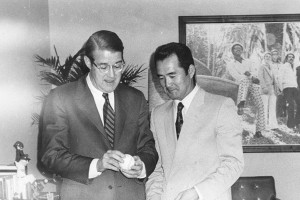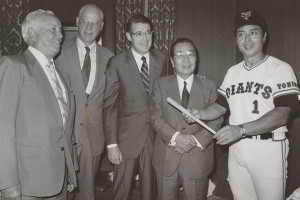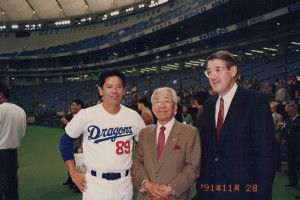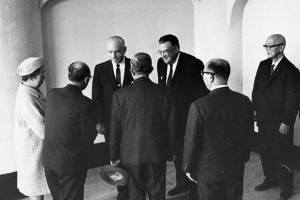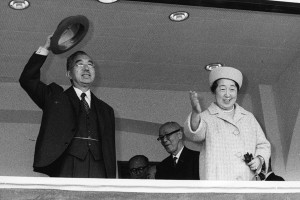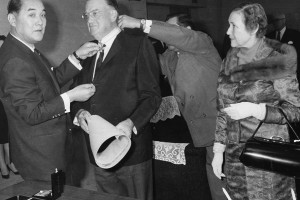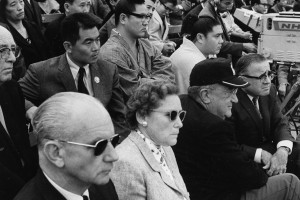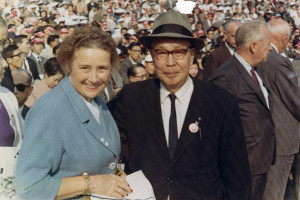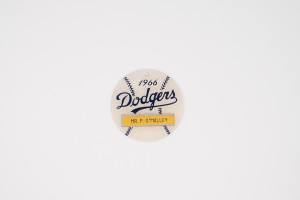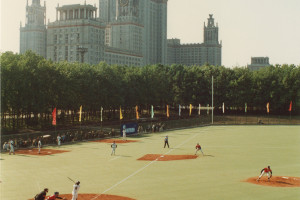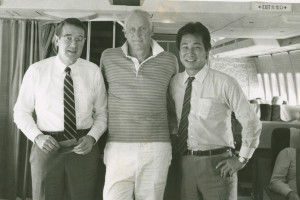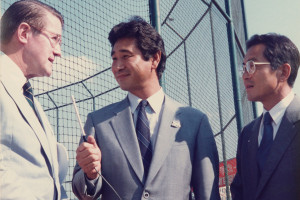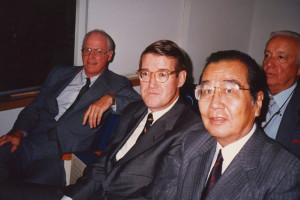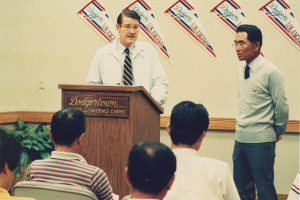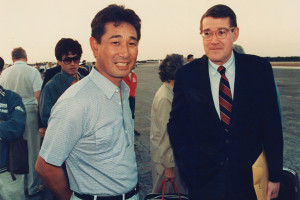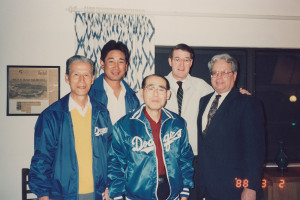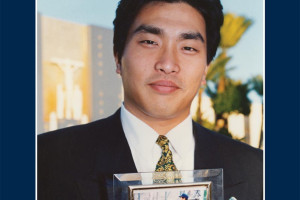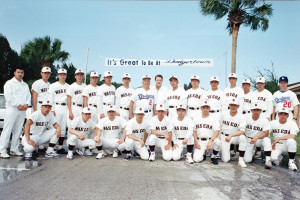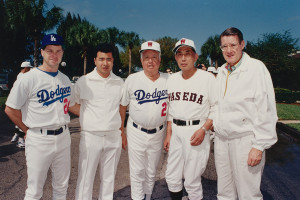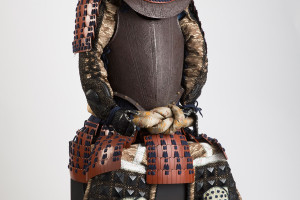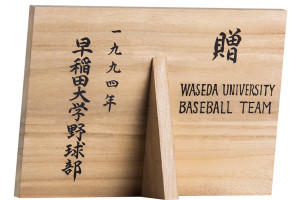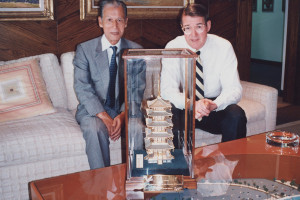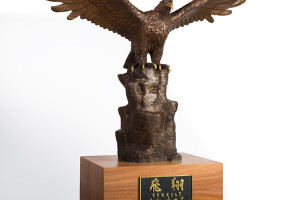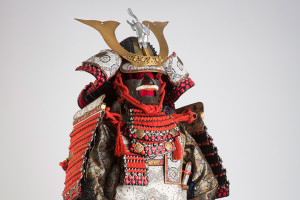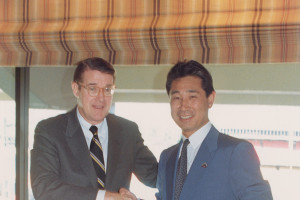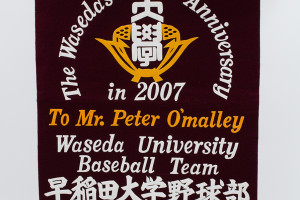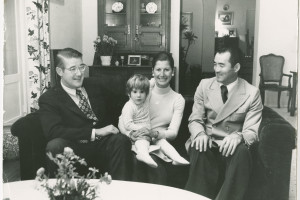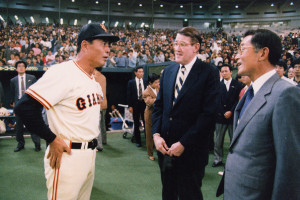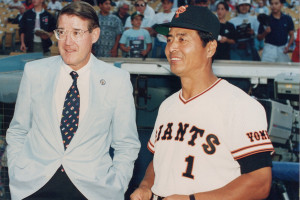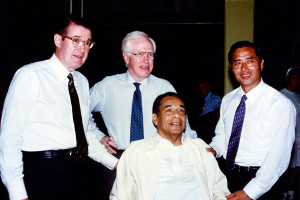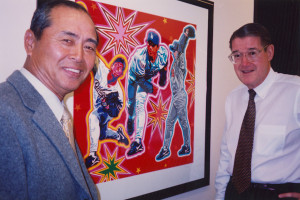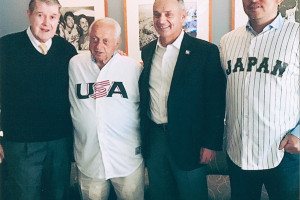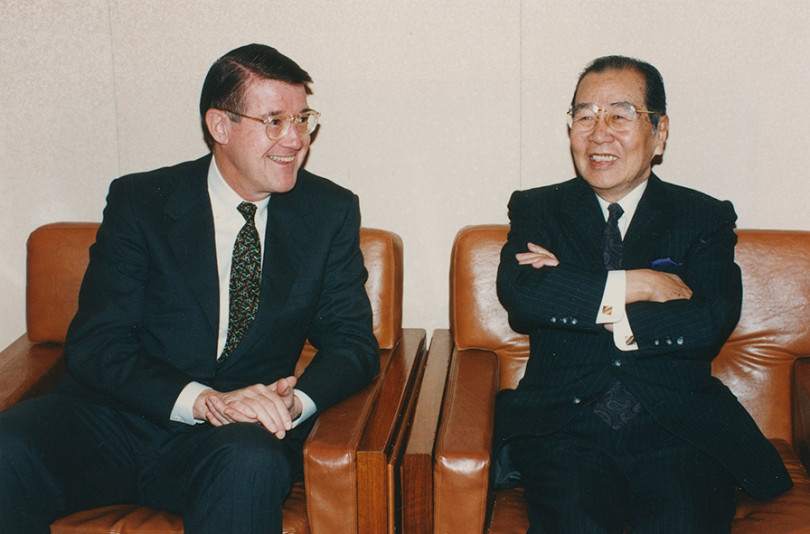
Dodger President Peter O’Malley with his longtime friend Tokyo Yomiuri Giants owner Toru Shoriki, circa the 1970s. O’Malley and Shoriki met on a regular basis in Tokyo, Los Angeles, Dodgertown, Vero Beach, Florida and elsewhere. Shoriki owned the Yomiuri Group, the parent company of Yomiuri Shimbun Holdings, the most prominent media company in Japan. The Giants were founded by his father, Matsutaro Shoriki, and Toru would later assume his duties.
Peter O’Malley and Japan: Friends, Friends, Friends
By Brent Shyer
The Japan baseball involvement of Peter O’Malley all dates back to traveling with his parents Kay and Walter, along with his sister Terry, on the Dodgers’ 1956 Goodwill Tour to Japan. It was the family’s first trip to Japan, a lengthy month-long journey for the Dodgers to play 19 exhibition games throughout the country.
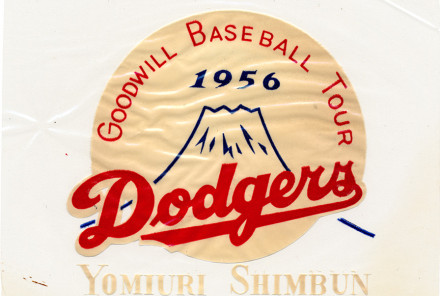
This unique cellophane is from the 1956 Dodgers Goodwill Tour to Japan showcasing the Dodger logo in red ink with Mt. Fuji as the centerpiece. The tour was sponsored by the Yomiuri Shimbun.
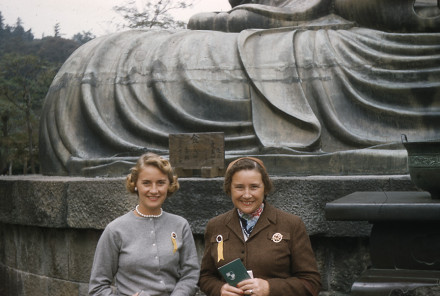
Terry O’Malley and her mother Kay are in front of the Kamakura Daibutsu (Great Buddha), a day trip outside of Tokyo, believed to be built in the 13th Century and weighs an estimated 121 tons. They were part of the Dodger traveling party for the 1956 Goodwill Tour to Japan.
The Dodgers and O’Malleys appreciated the warm welcome and generous hospitality from their hosts. The O’Malley family became immersed in the culture of Japan, partaking of unfamiliar food, visiting special sites and historic attractions, and enjoying shopping along the way. But, what appealed most to Walter, Kay, Terry and Peter was meeting people and making new friends. Baseball was just a game, albeit a shared pastime from New York to Tokyo, but the real thrill of the Goodwill Tour was how common understanding and bonds were formed by everyone making the trip. That whet Peter’s appetite to become involved with baseball in Japan.
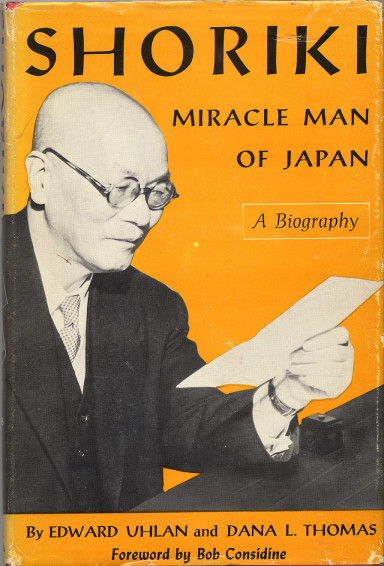
Front cover of the biography of Matsutaro Shoriki, the “father of professional baseball in Japan” and owner and publisher of the Yomiuri Shimbun newspaper and later founder of the Tokyo Yomiuri Giants. He was also founder of Nippon Television Network, Japan’s first commercial TV station. He trained as a lawyer and was a member of the Tokyo Police. In 1934, Shoriki sponsored a team of American baseball All-Stars, including Babe Ruth and Lou Gehrig, to play a Japan team which would later become the Yomiuri Giants for 12 games throughout Japan. After World War II, he became the first commissioner of baseball for the Nippon Professional Baseball teams. In 1959, Shoriki was inducted into the Japan Baseball Hall of Fame.
Much credit for starting the relationship rests upon Matsutaro Shoriki. He founded the Tokyo Yomiuri Giants, as well as Nippon Television Network, Japan’s first commercial TV station, owned the widely circulated Yomiuri Shimbun, and had a keen interest in bringing the United States and Japan closer together through baseball. He is known as the “father of professional baseball in Japan” for initially organizing its leagues in 1936. Shoriki sent Walter O’Malley a February 9, 1956 letter outlining his ideas for a goodwill tour for the Dodgers that fall. He informed O’Malley that he was authorizing well-respected sports columnist Sotaro Suzuki with power of attorney to negotiate on behalf of Yomiuri.
Shoriki’s confidant Suzuki immediately began the process of meeting and communicating with O’Malley in New York and discussing details of the proposed trip. Yomiuri, as it had done a handful of times before, would sponsor a baseball goodwill tour and promote it through the Yomiuri Shimbun and other sources.
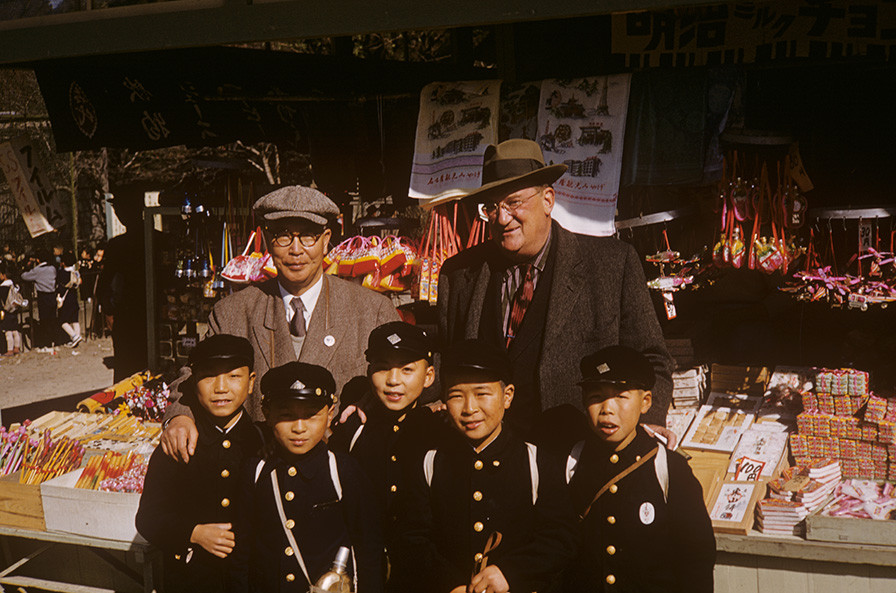
(L-R): Sotaro Suzuki, Japan Baseball Hall of Fame sports columnist; and Dodger President Walter O’Malley with Japanese schoolboys, during the 1956 Dodgers Goodwill Tour to Japan.
Japan was only a decade removed from the ravages of World War II and four years following the end of the Allied occupation. Feelings were frayed, the slow process of reconstruction was on-going and the popular sport of baseball increasingly gave hope for unification and normalcy. The Dodgers were defending World Champions at the time of their commitment to make the long postseason trip. In the fall of 1955, the Dodgers had celebrated winning the World Series against the New York Yankees. This was on the sixth consecutive occasion that the Dodgers had played the Yankees in the Fall Classic and they had lost the previous five times.
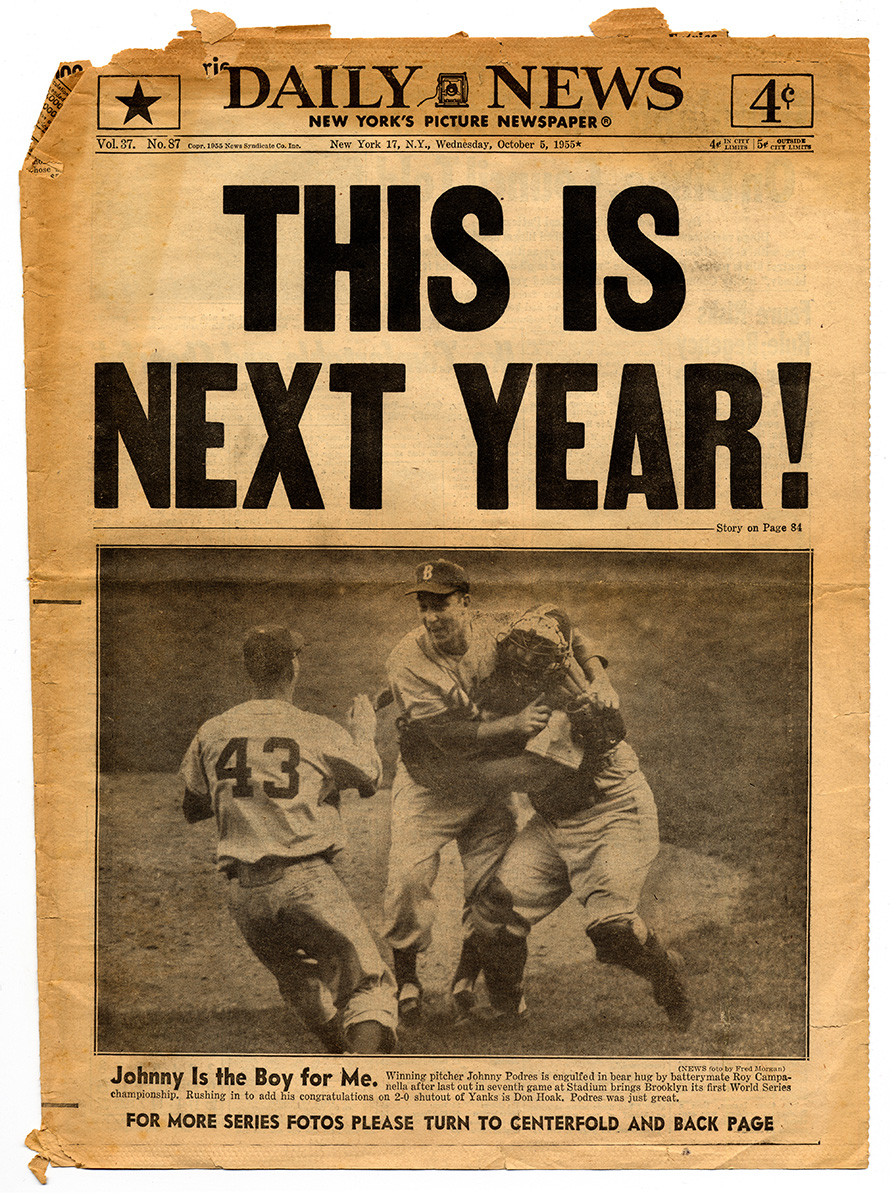
“THIS IS NEXT YEAR!” is the banner headline of the front page of the October 5, 1955 New York Daily News as Johnny Podres pitches a 2-0 shutout over the New York Yankees in Game 7 of the 1955 World Series on October 4. For years, frustrated Dodger fans in their hopes for the first Dodger World Championship would mutter, “Wait ’Til Next Year”. Podres starts celebrating with catcher Roy Campanella and third baseman Don Hoak.
The 1956 trip was a major undertaking, requiring the Dodgers to fly from New York to Los Angeles, Hawaii (for three exhibition games), Wake Island (stopover) and Tokyo – a distance of nearly 6,800 miles – after playing a regular season schedule and seven-game World Series. The Dodgers had already played 199 games, including spring games, and they still had 19 more to go in Japan.
Once the Department of State and the Baseball Commissioner’s office worked out the specifics with O’Malley, the tour was established and the Dodgers were to play exhibition games against the Tokyo Yomiuri Giants, as well as All-Star teams comprised of players from Japan’s two professional leagues.
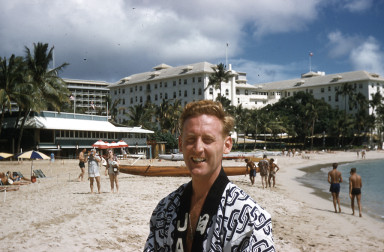
October, 1956, Dodger broadcaster Vin Scully enjoys a bit of relaxation on Waikiki Beach, Honolulu as the Dodger traveling party is in Hawaii to play three exhibition games before continuing to Japan for the 1956 Goodwill Tour and 19 more games. Scully and Peter O’Malley were roommates on the trip.
Photo by Peter O’Malley. All Rights Reserved.
At age 18, Peter O’Malley enjoyed experiencing the culture of Japan, its people, its baseball and seeing first-hand the opportunity that baseball has to bring countries together. He wanted to take advantage of that. O’Malley was also happy that talented Dodger broadcaster, 28-year-old Vin Scully, would be his roommate during their stay. As O’Malley tells it, everyone, including the players, had a roommate and his dad asked Scully if he would room with Peter. Scully said, “why not?” The two bonded and became best friends forever.
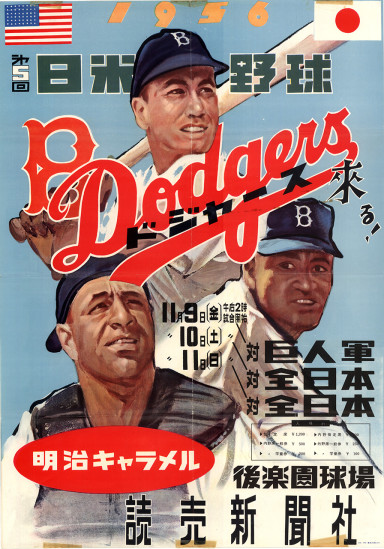
This rare, original promotional poster welcomes the 1956 National League Champion Brooklyn Dodgers on their first Goodwill Tour to Japan, with images of (left-right) future Dodger Hall of Famers Roy Campanella and Duke Snider and star pitcher Don Newcombe, who had a 27-7 record that season. The flags representing the USA and Japan top the poster, along with information about the games. In one month, the Dodgers played a total of 19 games before half a million fans throughout Japan.
“Our family’s trip to Japan in the fall of 1956 with the Dodger team on the Goodwill Tour made a profound impression on me,” said O’Malley. “We were in Japan for almost a month visiting different cities throughout and it was the very genuine feeling about the people of Japan that I have always remembered. Major League players and teams had been there before but the baseball fans were in awe watching Jackie Robinson, Roy Campanella, Duke Snider, Pee Wee Reese, Gil Hodges and that Hall of Fame team.
“Hodges played left field for some of the games and in pantomime between pitches he would imitate the pitcher’s windup or a batter’s swing and everyone in the stadium thought that was fun. His connection to the fans showed me what could be done in a true goodwill sense. Also, between innings instead of our infielders throwing around the baseball they went through a phantom infield (the motion of throwing and catching without a ball). That also got everybody’s attention.
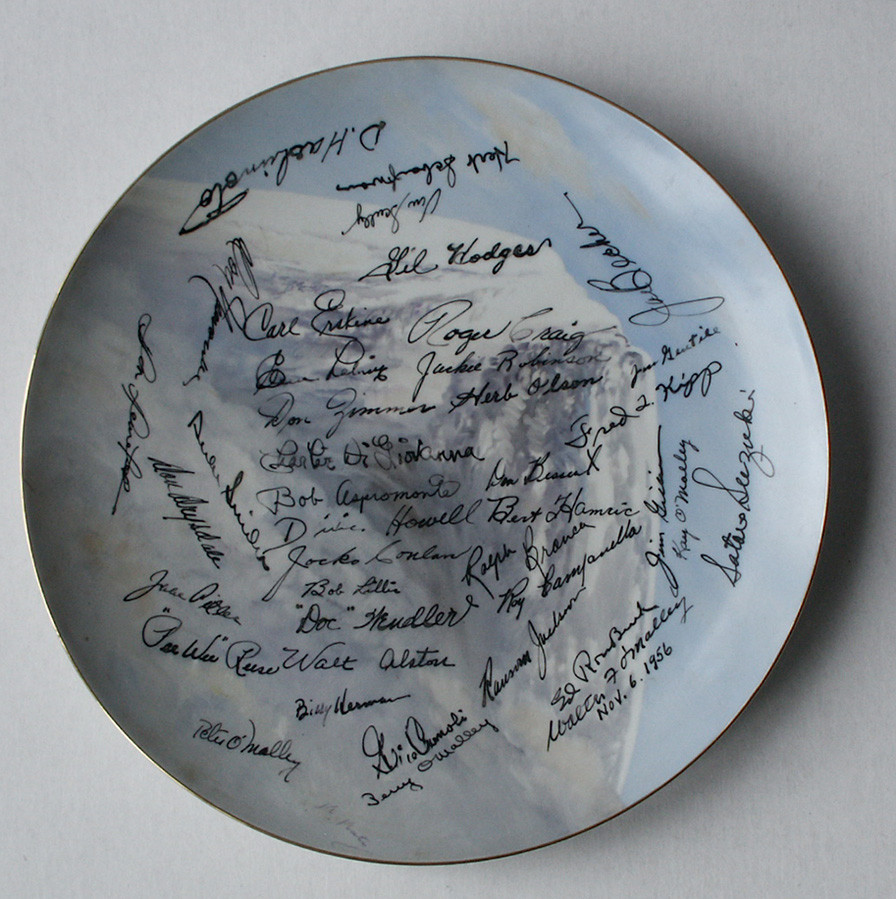
Twelve Baseball Hall of Famers signed this one-of-a-kind plate, presented to Dodger President Walter O’Malley on November 6, 1956. The plate with Mt. Fuji in the background includes 40 autographs, including 11 Baseball Hall of Fame members of the Dodgers on the 1956 Goodwill Tour to Japan. Sotaro Suzuki, the emissary to Tokyo Yomiuri Giants founder Matsutaro Shoriki, is a Japan Baseball Hall of Fame sports columnist.
“Fortunately, we met players, umpires, executives, team owners, league presidents and the commissioner and that was the beginning of lifetime friendships. Sotaro Suzuki, confidant of Matsutarō Shoriki, founder of Yomiuri and the Tokyo Giants and sponsor of the trip, also deserves a lot of credit. He was a very likable ambassador type and we kept in touch with him until he passed away in 1982. When we invited the Tokyo Giants and other teams to Dodgertown, Vero Beach, Florida for spring training that solidified friendships. All the players, coaches, and trainers appreciated the enthusiastic support and encouragement everyone in the Dodger organization gave them.”
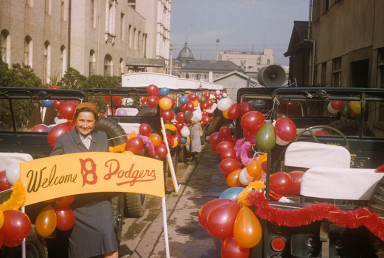
Kay O’Malley, wife of Walter O’Malley, stands by a group of army jeeps before a parade is to commence for the Dodgers in Tokyo, Japan as part of the 1956 Goodwill Tour, October, 1956.
Photo by Peter O’Malley. All Rights Reserved.
Peter’s mom Kay, the First Lady of the Dodgers, wrote a letter to her family back home on October 21, 1956 about the delayed team arrival in the rain to Haneda Airport, Tokyo and a planned parade: “We are all well and very glad to have arrived in Tokyo after a 5 hour delay at Wake Island for a repair plane job and a flat tire. The parade from airport inspiring and was very impressive. Both sides of street lined with people. 1 hour journey. They estimate 500,000 people – all smiling and waving flags. Walter (O’Malley) and Mr. (Warren) Giles (National League President) and Mr. Suzuki stood up in the car at certain points and the crowd cheered. Our car was the only open car and we got wet but it was so thrilling it was worth it.”
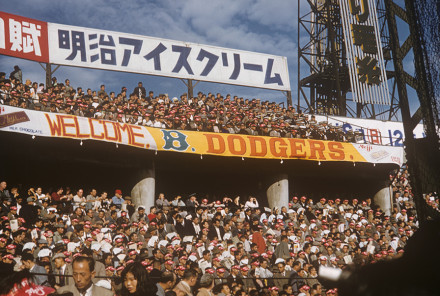
In October, 1956, a banner at Korakuen Stadium in Tokyo, Japan welcomes the Brooklyn Dodgers for their 1956 Goodwill Tour to Japan to play exhibition games against professional teams and All-Stars. During their 30-day tour throughout the country, the Dodgers were warmly welcomed by large crowds everywhere.
Photo by Peter O’Malley. All Rights Reserved.
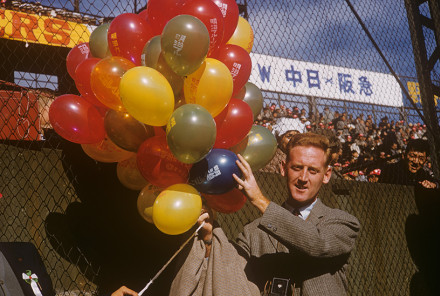
Dodger broadcaster Vin Scully holds up a set of balloons on the field at Korakuen Stadium in Tokyo during the 1956 Dodgers Goodwill Tour to Japan. The photo was taken by Scully’s roommate on the trip, Peter O’Malley, the future Dodger President. Scully is considered the greatest sports broadcaster of all-time, serving 67 seasons with the Dodgers.
Photo by Peter O’Malley. All Rights Reserved.
Peter O’Malley was also happy to see a half million enthusiastic and knowledgeable fans attend games in Japan. That guided his interest in aiding those around the world who also loved playing the game at all levels, from Little League, amateur and college to the professionals. Wherever there was interest in pursuing and developing baseball, O’Malley wanted to learn from other countries and be part of supporting it and securing its future.
Ryozo Kato was just 15 years old when he attended the second game of the Dodgers’ 1956 Goodwill Tour to Japan. The game was at Tokyo’s Korakuen Stadium and he watched the Dodgers beat a team of All-Central League All-Stars, 7-1. Kato was impressed with the Dodgers, the journey that they had made from Brooklyn, New York and the stars like Jackie Robinson, Pee Wee Reese, Duke Snider, Roy Campanella and Gil Hodges who had jumped off the sports pages and into real life in his home country.
From that moment, he was a passionate baseball fan. Baseball had meaning to him for its societal impact, as he saw a Major League Baseball team visit Japan and the excitement and joy it brought his country. Kato couldn’t have been prouder and it would lead him to a life of diplomacy, garnered in large part from the diplomacy on the diamond.
Although they did not know it at the time, Kato and O’Malley attended the same game on October 20 of the 1956 Goodwill Tour. And, decades later, their lives would cross, O’Malley as former Dodger President and Kato as Commissioner of Baseball in Japan from 2008-2013. Kato also was Chairman of the Baseball Hall of Fame and Museum in Tokyo when a special exhibit “Baseball in Japan and the O’Malley Family: A Lasting Friendship” was held from June 29-July 15, 2013.
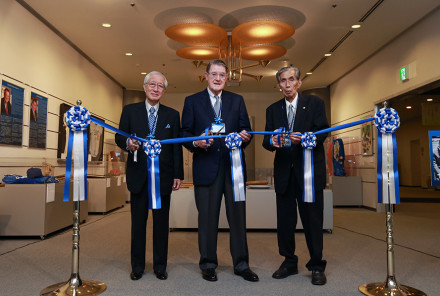
On June 29, 2013, Tokyo, Japan at the Japan Baseball Hall of Fame and Museum’s “Baseball in Japan and the O’Malley Family: A Lasting Friendship” exhibit. (L-R): Ryozo Kato, Commissioner of Nippon Professional Baseball and Chairman of the Board of Directors, Japan Baseball Hall of Fame; Peter O’Malley; Renzo Ishii, former head baseball coach Waseda University and 2022 Japan Baseball Hall of Famer. Prior to becoming Baseball Commissioner, Kato was an accomplished Japanese diplomat for his government and served as the Japan Ambassador to the United States in 2001-2008.
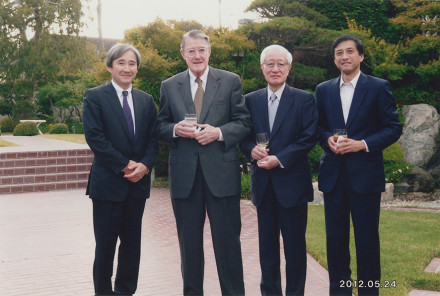
(L-R): Yasuyuki Sugiura, President and CEO, Mitsubishi International Corporation; Peter O’Malley; Ryozo Kato, former Japan Ambassador to the U.S. and Japan Baseball Commissioner (2008-2013); and Jun Niimi, Consul General of Japan in Los Angeles. Photo taken May 24, 2012 at the residence of the Consul General Los Angeles.
The exhibit celebrated the 110th Anniversary of the 1903 birth of Walter O’Malley and the long-term goodwill and exchanges that the family and Japan have enjoyed for decades. Kato alongside Peter O’Malley cut the ribbon for the exhibit’s opening. Prior to his commissionership, career diplomat Kato served as Japan’s Ambassador to the United States from 2001-2008.
Though the Dodgers completed the tour with a 14-4-1 record, wins and losses paled in comparison to the depth of understanding and friendships created while in Japan. In one of the most emotional moments of the entire tour, the Dodgers visited Hiroshima. Only a small group of Dodger traveling members were permitted to attend. Prior to the game and already in their Dodger uniforms, the team paid respects at the Cenotaph for the Victims of the Atomic Bomb in Hiroshima Peace Memorial Park.
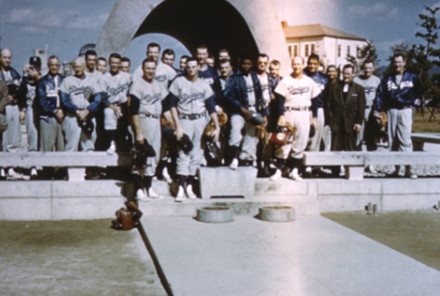
As part of their 1956 Goodwill Tour to Japan, the Dodgers made a November 1 stop in Hiroshima and paid respects at the Cenotaph for the Victims of the Atomic Bomb in Memorial Peace Park. The Dodgers played an exhibition game against the Kansai All-Stars and won, 10-6. Prior to the game, Dodger executives and players participated in ceremonies to dedicate a bronze plaque at the entrance of the Hiroshima ballpark. Inscribed on the plaque were the words written by Dodger President Walter O’Malley, “We dedicate this visit in memory of those baseball fans and others who here died by atomic action on August 6, 1945. May their souls rest in peace and with God’s help and man’s resolution peace will prevail forever, amen.”
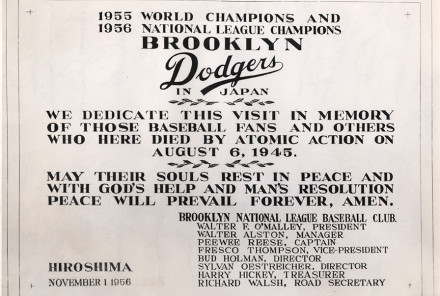
On November 1, 1956, a bronze plaque is donated by the Dodgers for the entrance to Hiroshima Stadium in Japan after the Dodgers had visited the Cenotaph for the Victims of the Atomic Bomb in Hiroshima Peace Memorial Park that day. The bronze plaque was relocated into a suite at the current Hiroshima ballpark.
It was a somber occasion, just a little more than a decade removed from the U.S. dropping of the atomic bomb in that city. Walter O’Malley wrote the wording for a bronze plaque that was presented to officials to be installed at the entrance to Hiroshima Stadium, where the Dodgers would play an exhibition game on November 1, 1956. The plaque read, “We dedicate this visit in memory of those baseball fans and others who here died by atomic action on August 6, 1945. May their souls rest in peace and with God’s help and man’s resolution peace will prevail forever, amen.” The plaque bore the names of Dodger President Walter O’Malley, Dodger Manager Walter Alston, Dodger team captain Pee Wee Reese and other club officials.
To continue the friendships that started in the fall of 1956, O’Malley invited Shigeru Mizuhara, Japan Baseball Hall of Fame Manager and two players -- pitcher Sho Horiuchi and catcher Shigeru Fujio – of the Tokyo Yomiuri Giants to Dodgertown, Vero Beach, Florida to observe and learn techniques while training in the spring of 1957. O’Malley also invited Suzuki to attend the activities at Dodgertown. Suzuki was not only a goodwill ambassador for Yomiuri in dealings with the Dodgers and other major league teams such as the New York Giants and New York Yankees to tour Japan, he was a prolific columnist and baseball expert. It was Suzuki who in person invited Babe Ruth to take a 1934 tour to Japan by creating a mock-up poster featuring Ruth’s larger-than-life likeness on it. That impressed the Yankees’ star and he agreed to make the tour, along with many other major league All-Stars. Suzuki, author of several baseball books, wrote one about Ruth’s Japan visit.

In the May 9, 2016 Wall Street Journal a sports headline was “Sixty Years Ago, the Dodgers Toured Japan and Changed Baseball Forever”. The article featured the longtime relationship between the Dodgers and Japan that started in 1956 as the Dodgers shared instructional methods to improve Japanese baseball and continued through the signing of Hideo Nomo.
The Wall Street Journal took notice of the impact of the 1956 Dodgers Goodwill Tour in its powerful headline on May 9, 2016, “Sixty Years Ago, the Dodgers Toured Japan and Changed Baseball Forever”.
The article by Brad Lefton explains the friendship that started between the O’Malley family and the Tokyo Yomiuri Giants, as the National League Champion Dodgers made the 19-game trip to Japan. But, more importantly, the building of bridges and expansion of those bonds led to more and more exchanges through the decades and the ultimate: the eventual 1995 Dodger signing of Japan-born pitcher Hideo Nomo.
When Nomo became a free agent and selected the Dodgers to continue his professional career challenging the world’s best hitters, it was a groundbreaking decision that made a major impact on two continents. Neither Major League Baseball nor Nippon Professional Baseball would remain the same. Nomo’s immediate success and longevity as the first Japan-born player to stay in the U.S. major leagues and complete his career meant that others could follow his example. And they did, as more than 65 additional Japan-born players have come to Major League Baseball (to start the 2025 season) including Shohei Ohtani, and Ichiro Suzuki, a Baseball Hall of Famer in the United States (the first) and in Japan.
Through the years, Peter O’Malley established many long-lasting trans-Pacific friendships. His time and efforts were met with appreciation. Some of the Dodgers’ and his involvement includes:
*Meeting with baseball leaders and players at Dodgertown, Vero Beach, Florida, at Dodger Stadium, Los Angeles, and in Japan for the betterment of the game
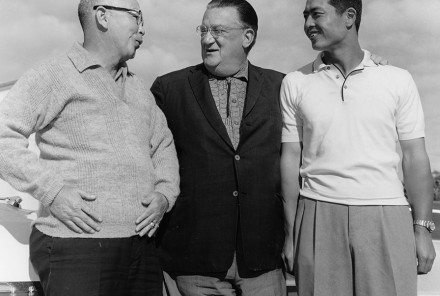
(L-R): Japan Baseball Hall of Fame sports columnist Sotaro Suzuki; Dodger President Walter O’Malley; and Sadaharu Oh, Japan Baseball Hall of Fame member. In spring, 1961, O’Malley welcomes Suzuki and Tokyo Yomiuri Giants star Oh to Dodgertown, Vero Beach, Florida. It was the first team visit of five by the Giants to Dodgertown.
Courtesy of University of Southern California, on behalf of the USC Specialized Libraries and Archival Collections
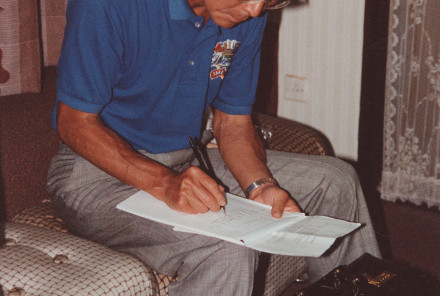
Akihiro “Ike” Ikuhara, Assistant to President Peter O’Malley, circa 1990 at Dodgertown, Vero Beach, Florida. He worked in conjunction with O’Malley for the growth of international baseball and the emergence of players from Asia to play in the major leagues. Ikuhara was posthumously elected to the Japan Baseball Hall of Fame in 2002, the only USA Major League Baseball executive so honored.
*Inviting and welcoming professional and amateur teams to train and stay at world-famous Dodgertown, Vero Beach, Florida to learn more about training techniques and bringing everyone together at a critical time of year preparing for a new season
*Sending instructors to Japan to help teach baseball fundamentals, skills and discuss strategy
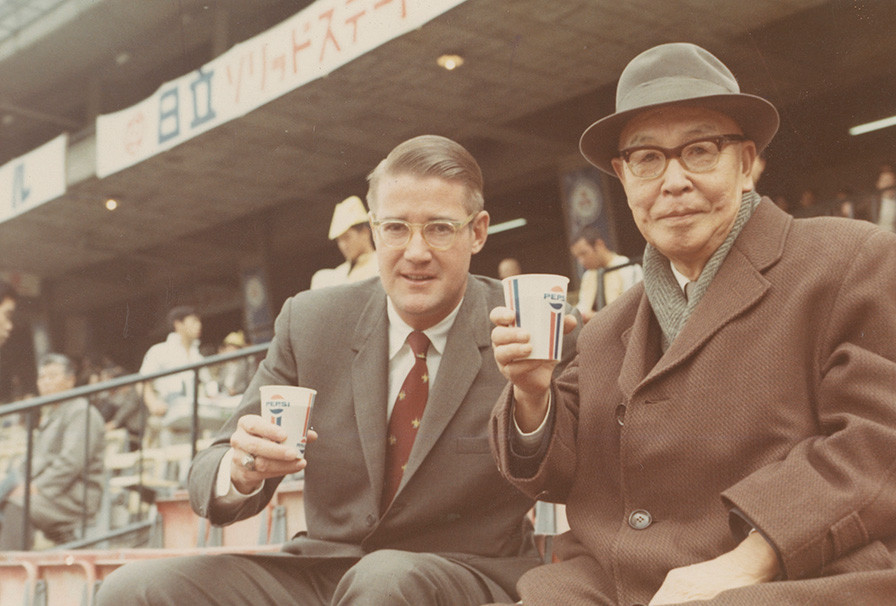
Dodger President Peter O’Malley with Japan Baseball Hall of Fame columnist Sotaro Suzuki at the 1970 Japan Series, October 29 at Korakuen Stadium, Tokyo. O’Malley became the first official of a major league team to attend a Japan Series. The Tokyo Yomiuri Giants beat the Lotte Orions in five games on November 2.
*Attending the 1970 Japan Series, the first MLB team president to do so
*Arranging for former Dodgers to play in Japan’s professional Central and Pacific Leagues
*Traveling with Tokyo Yomiuri Giants owner Toru Shoriki to select Pacific Coast League (Triple-A) sites
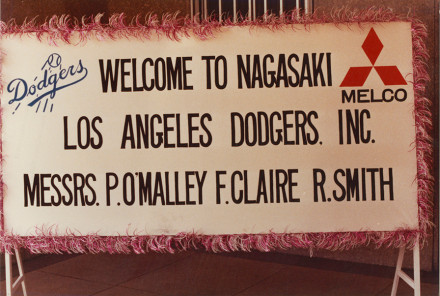
February 12-13, 1980. Sign at Mitsubishi Electric Corporation in Nagasaki, Japan welcomes Dodger President Peter O’Malley; Dodger Vice President Public Relations and Promotions Fred Claire; Dodger Director, Stadium Operations Bob Smith; and interpreter and Administrative Assistant Akihiro “Ike” Ikuhara for final discussions for the use of Diamond Vision at Dodger Stadium. Diamond Vision made its historic debut at the 1980 MLB All-Star Game at Dodger Stadium, changing in-game fan entertainment forever. The first test image displayed on Diamond Vision occurred on Friday, July 4, 1980 when the Dodger logo was displayed.
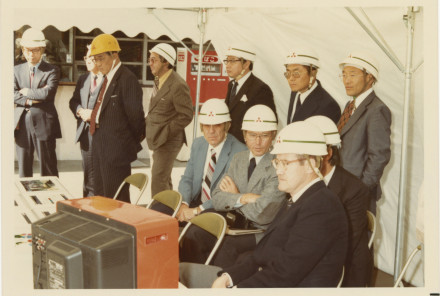
February 12-13, 1980. Seated (L-R): Bob Smith, Dodger Director, Stadium Operations; Fred Claire, Dodger Vice President, Public Relations and Promotions; Unidentified; Dodger President Peter O’Malley. Back – Akihiro “Ike” Ikuhara is standing second from the right. Dodger executives are present in Nagasaki, Japan for a 1/30th scale-model demonstration of Diamond Vision, a color large-screen video display for messages and videos at Dodger Stadium.
*Installing at Dodger Stadium the world’s first full-color, large screen video board made by Mitsubishi Electric in 1980, which was a game changer for in-stadium entertainment
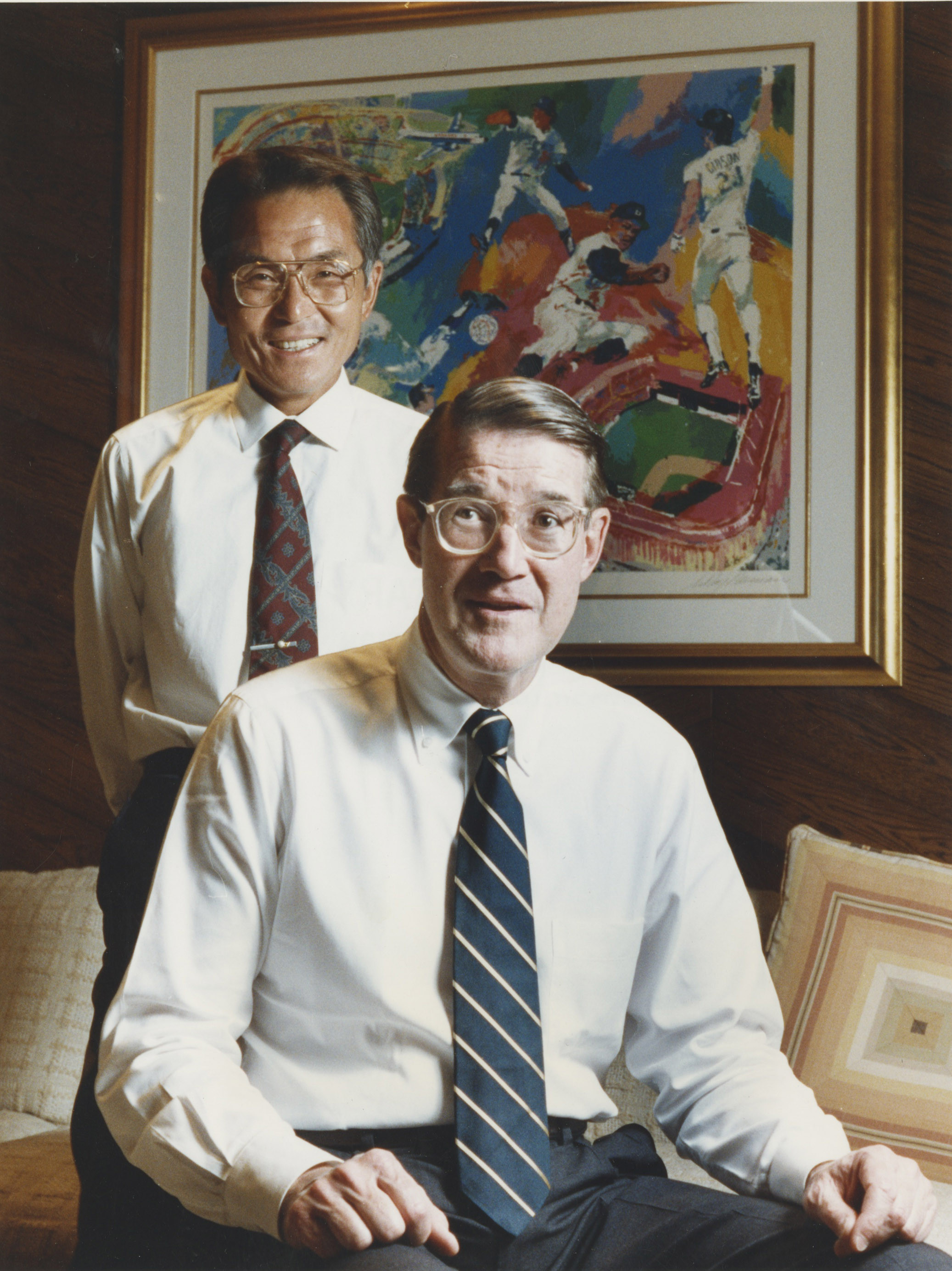
(L-R): Dodger President Peter O’Malley (seated) with his longtime Assistant to the President Akihiro “Ike” Ikuhara standing in O’Malley’s office at Dodger Stadium, circa 1990. For his contributions to international baseball, Ikuhara was elected to the Japan Baseball Hall of Fame in 2002, the only executive from a Major League Baseball team to have that honor.
*Naming Japan-born Akihiro “Ike” Ikuhara his full-time Assistant to the President in 1982. Ike became the first MLB executive inducted into the Japan Baseball Hall of Fame
*Inviting representatives from Japan’s professional leagues to observe Dodger organizational meetings
*Making special arrangements for Japan-born players to compete in U.S. minor league teams and assisting with their development
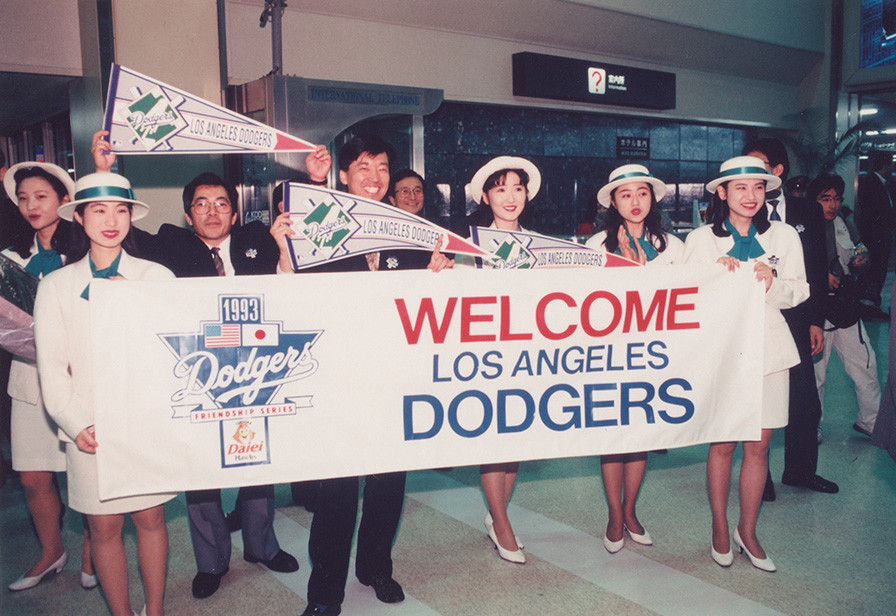
A banner at the airport upon the Dodgers’ arrival to Fukuoka, Japan, the second leg of their 1993 Friendship Series to Taiwan and Japan. They played two exhibition games with the professional Daiei Hawks in the Fukuoka Dome.
*Leading the Dodgers on a post-season Friendship Series to Fukuoka in 1993, which included two exhibition games against the Daiei Hawks, clinics and a visit to the children’s hospital
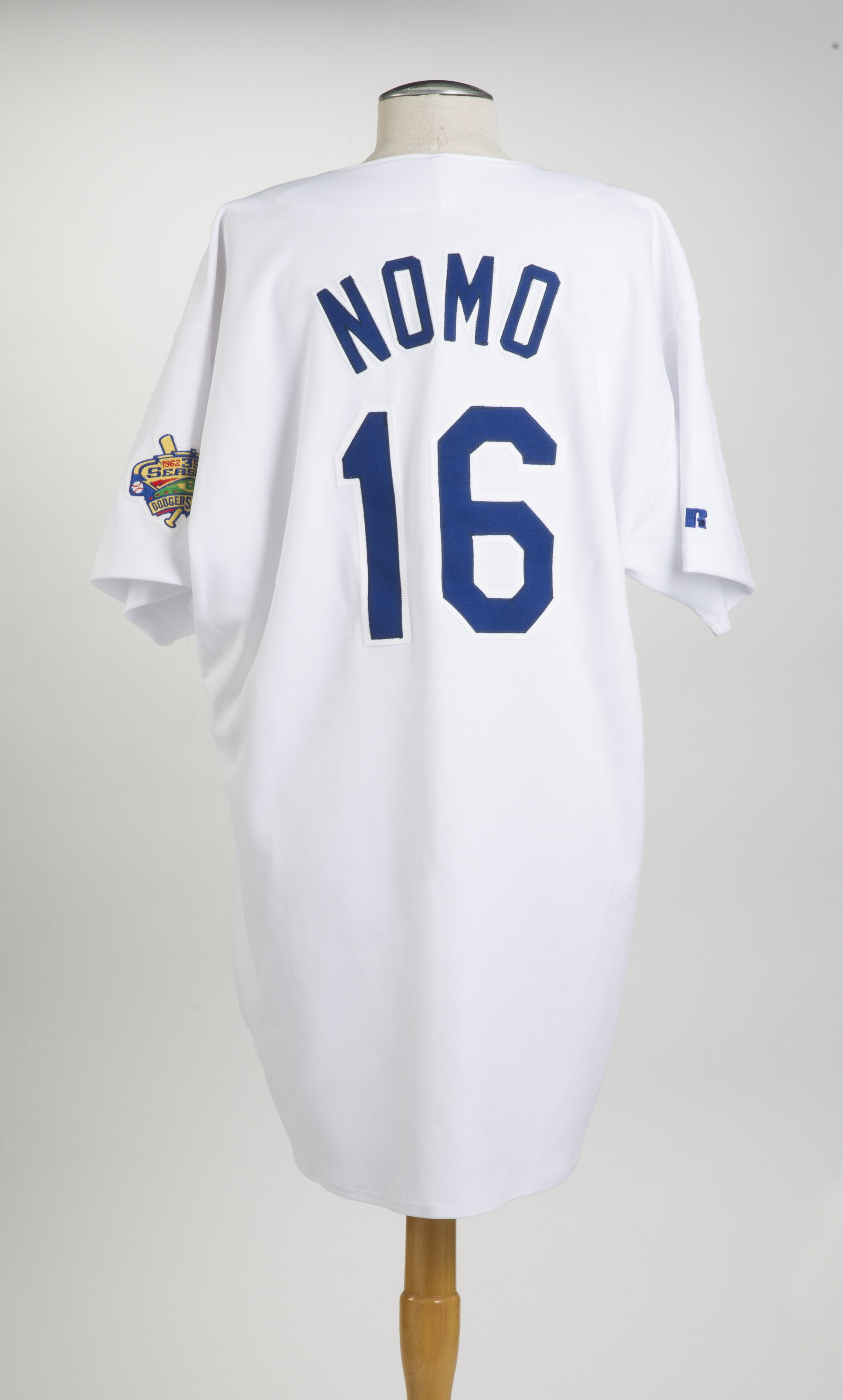
Hideo Nomo’s official Dodger jersey (No. 16) from 1996 was presented by him to Dodger President Peter O’Malley. Nomo was the 1995 National League Rookie of the Year after finishing the season with 13 wins and a start in the All-Star Game and launching the “Nomomania” phenomenon. Nomo won 16 games for the Dodgers in 1996. The jersey includes a patch worn by the Dodgers during their 35th Anniversary of Dodger Stadium.
Photo for OSP by David Johnston
*Signing free agent pitcher Hideo Nomo, the first Japan-born player in 30 years in the major leagues
*Publishing the Dodgers Line Drives newsletter and pocket schedules in Japanese
*Welcoming Japan American citizens to Dodger Stadium with Japanese Community Nights
*Hiring Hiromichi Ishige, retired player from the Daiei Hawks, to join the Dodgers’ coaching staff
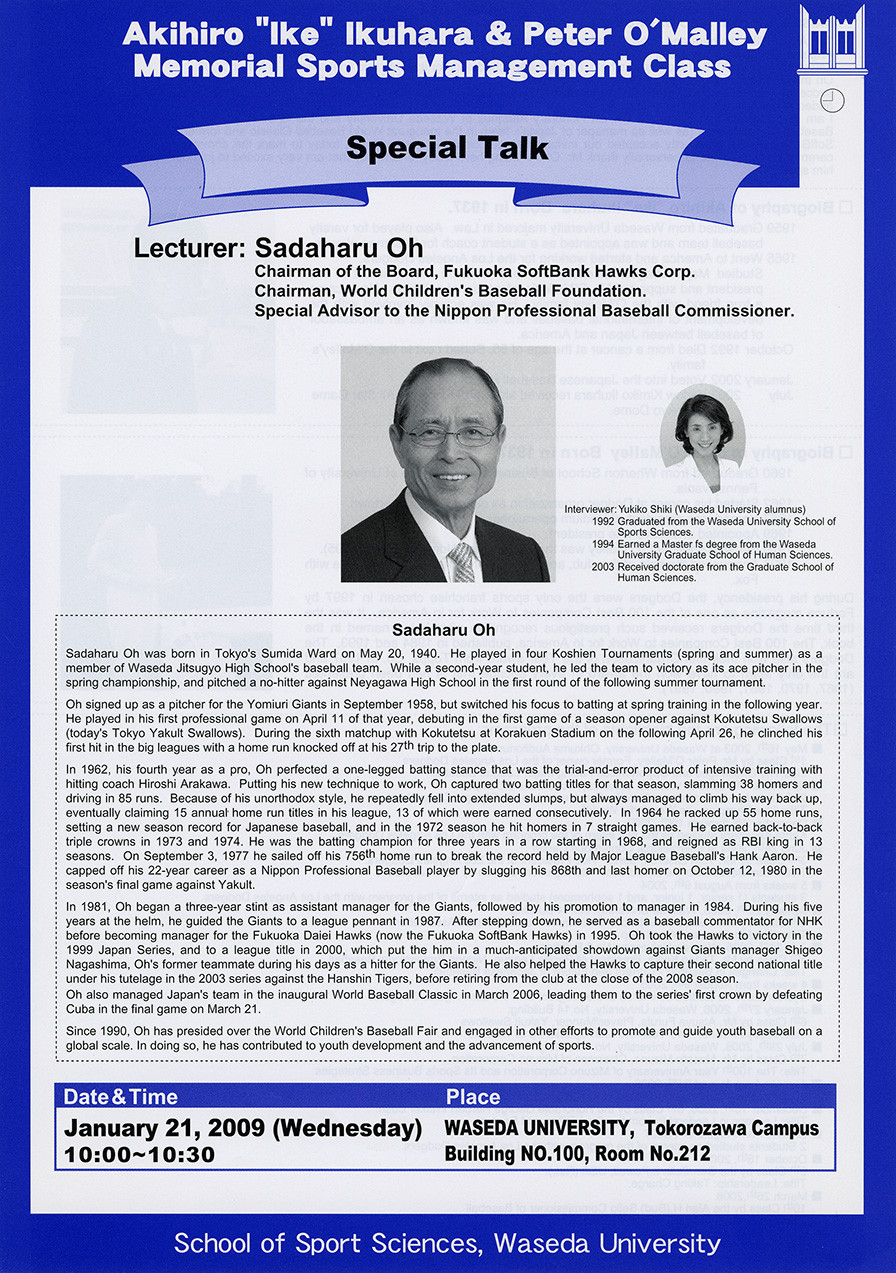
On January 21, 2009, Sadaharu Oh spoke to the 11th Class of the Akihiro “Ike” Ikuhara and Peter O’Malley Memorial Sports Management Class at Waseda University, Tokyo. This is the flyer for that talk from Oh, a Japan Baseball Hall of Famer with the Tokyo Yomiuri Giants.
*Establishing, developing and sponsoring the Akihiro “Ike” Ikuhara and Peter O’Malley Memorial Sports Management Class at Waseda University, Tokyo
*Joining with Japan Hall of Fame pitcher Hideo Nomo as a founding partner to save Dodgertown, Vero Beach, Florida as a year-round, training center for professional, amateur and youth sports teams
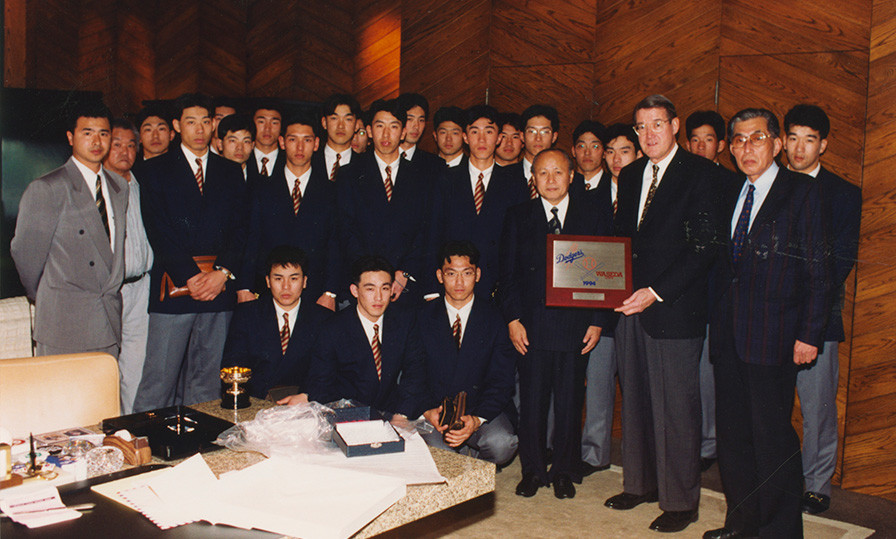
On March 3, 1994, Dodger President Peter O’Malley welcomed and met the entire Waseda University baseball team in his Dodger Stadium office. The Waseda baseball team had trained for two weeks alongside the major league Dodgers at Dodgertown, Vero Beach, Florida and then played college teams in Florida. They stopped in Los Angeles for a workout before their return to Japan the next day.
*Hosting annual dinners at Lawry’s in Beverly Hills, CA for Hideo Nomo’s youth all-star teams when they travel to Los Angeles, as well as dinner at Lawry’s for Waseda University’s baseball team whenever they are in town
*Serving as a member of the Japan House Los Angeles Steering Committee, as appointed by the Japan Minister for Foreign Affairs
“International baseball is my hobby,” O’Malley has said.
The Japan and O’Malley baseball relationship is unique. Just five years after Peter O’Malley had been to Japan, he was fresh out of college and ready to be actively involved with baseball. In the spring of 1961, he was responsible for all arrangements and schedule from arrival to departure when the Tokyo Yomiuri Giants made their first team visit to Dodgertown, Vero Beach, Florida.
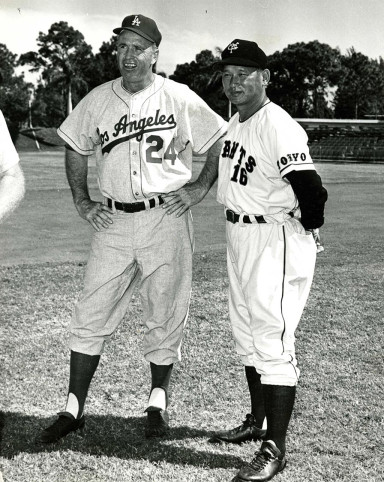
(L-R): Dodger Manager Walter Alston and Tokyo Yomiuri Giants Manager Tetsuharu Kawakami during 1961 Spring Training at Dodgertown, Vero Beach, Florida. Alston won four World Championships for the Dodgers and was elected to the National Baseball Hall of Fame in 1983. Kawakami managed the Yomiuri Giants to 11 Japan Series championships, including 9 consecutive titles, and was inducted into the Japan Baseball Hall of Fame in 1965.
That was the start of many of his relationships, solidifying friendships from 1956 and getting to know Giants Manager Tetsuharu Kawakami and all-time great players like Sadaharu Oh and Shigeo Nagashima, who were making their first visit, among others. O’Malley could see how global baseball would continue to improve as a team like the Giants were provided instruction, fundamentals, strategy and an exchange of ideas for training. Matsutaro Shoriki wrote a letter to Dodger President Walter O’Malley on February 25, 1961 stating, “I know, as well as the members themselves, that there are many things Japanese baseball players can learn from your team, one of the outstanding baseball teams of America, the home of baseball. I am looking forward to the team’s return to Japan for I am sure they will be able to contribute much toward improving baseball in Japan after training with the Dodgers.
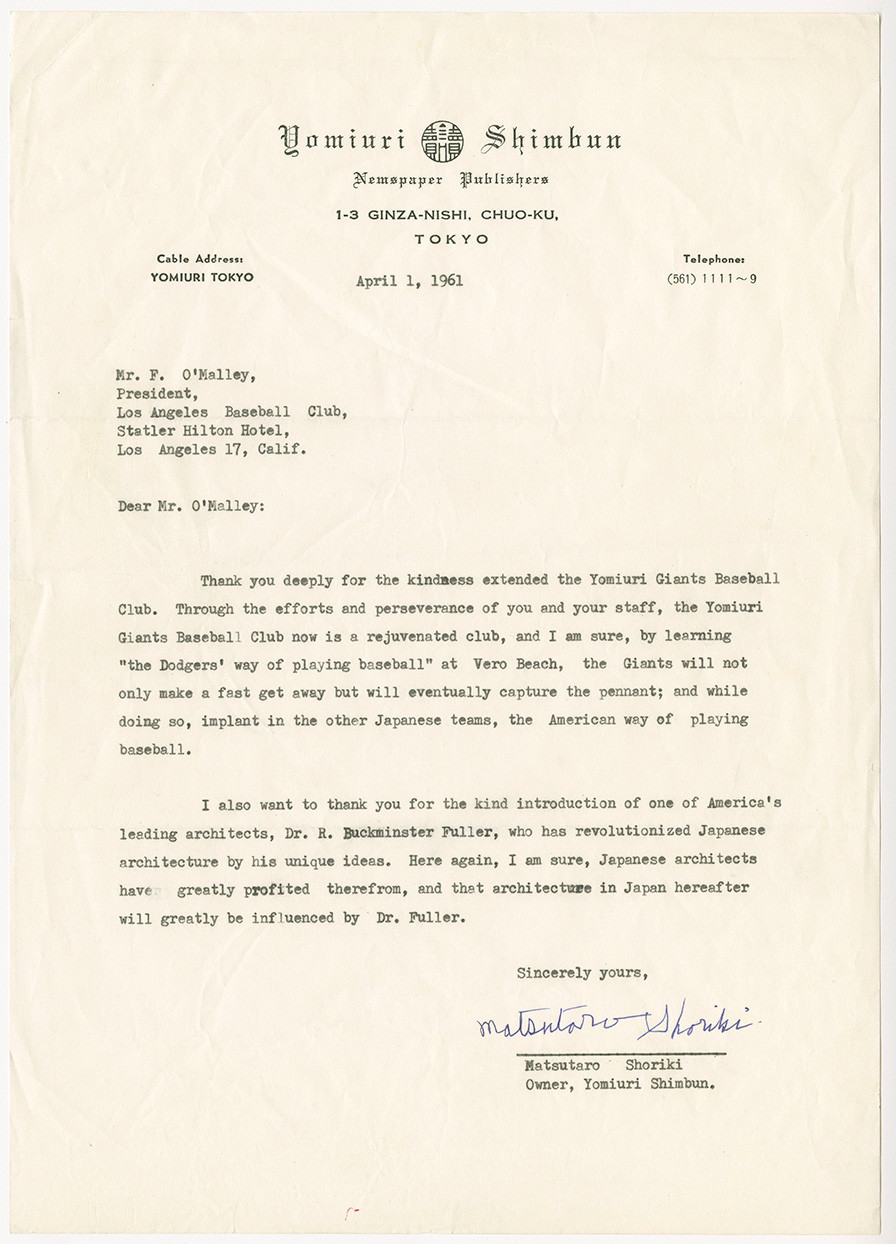
Matsutaro Shoriki, owner and founder of the Tokyo Yomiuri Giants, writes an April 1, 1961 letter to Dodger President Walter O’Malley thanking him for inviting the Giants to train as a team for the first time at Dodgertown, Vero Beach, Florida and learn “the Dodgers’ way of playing baseball.” Two generations of the O’Malley and Shoriki families became good friends through the years.
“Since many of the members are visiting your country for the first time in their life, there are many things they have to learn about your customs and manners, aside from things concerning baseball itself. I am sure that you will be understanding about whatever shortcomings they might have in adjusting themselves to the life in America, while you and your team will spare no effort to make them good ball players. Yours truly, Matsutaro Shoriki” Matsutaro Shoriki letter to Walter O’Malley, February 25, 1961, O’Malley collection
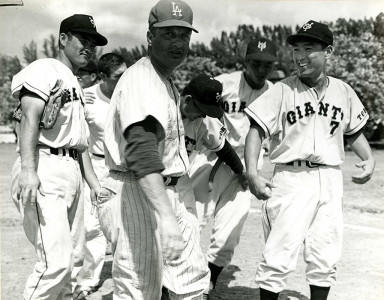
Future Hall of Fame Dodger Manager Tommy Lasorda works as an instructor during the Tokyo Yomiuri Giants’ 1961 spring training visit to Dodgertown, Vero Beach, Florida. Wearing number 7 for the Giants is outfielder Tsuneo Takabayashi.
Oh said of that early experience at Dodgertown, “The training grounds were the most beautiful I had ever seen. The centerpiece was Holman Stadium, with stands of individual seats for each customer and beautifully kept grass. There was nothing ever close to it in Japan. And then, in addition to that, there were all these other baseball diamonds in the same complex. I was simply blown away by the scale of it.
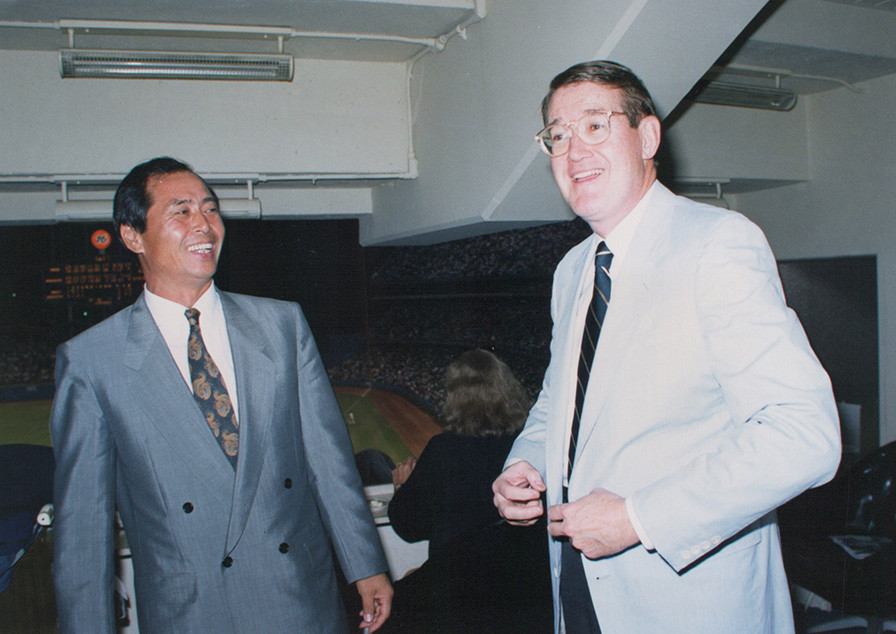
On July 31, 1990, Dodger Stadium, Los Angeles, in the Chairman’s Box, Japan Baseball Hall of Famer Sadaharu Oh, Nippon Professional Baseball’s all-time home run king, and Dodger President Peter O’Malley. Oh is the greatest home run hitter in the entire world. For his career in Japan with the Tokyo Yomiuri Giants, he hit 868 home runs and his feats are legendary in baseball circles. In Japan, he is the all-time leader in home runs, RBI, slugging percentage, and walks.
“Up until then, defensively, Japanese baseball was reactionary, not anticipatory. For example, the Dodgers preached to anticipate the bunt and charge in with the pitch. That kind of thing was unheard of in Japan. They taught the infielders how to move in tandem with the pitcher and play a more team-oriented defense. It completely changed the way we defended.” Brad Lefton, Wall Street Journal, May 9, 2016
Nagashima said, “I first met Mr. (Peter) O’Malley in 1961 when Yomiuri Giants went to Vero Beach for training camp. He kindly made the arrangements for the 40-day long camp. Since then, we have had a great relationship over half a century.”
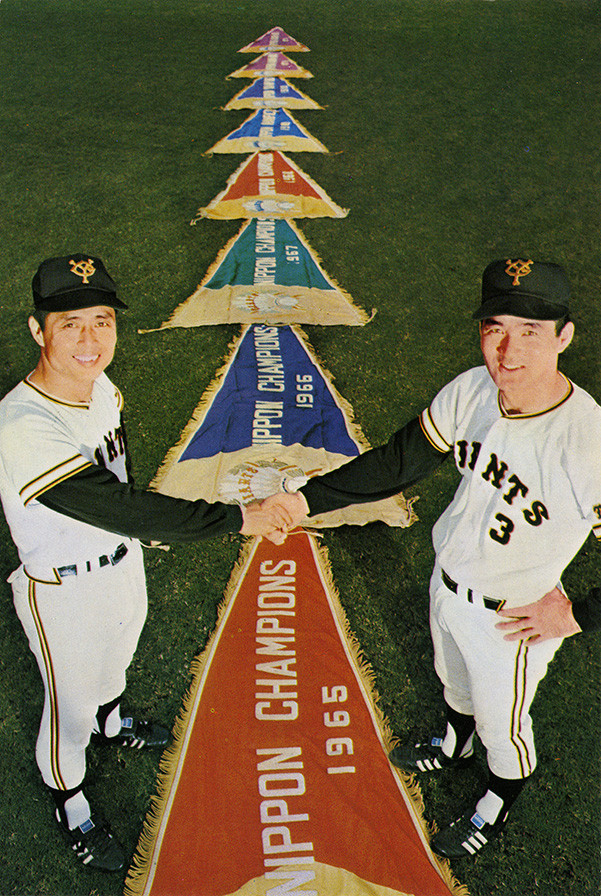
Postcard of Tokyo Yomiuri Giant players Sadaharu Oh (left) and Shigeo Nagashima (right). Both players were inducted into the Japan Baseball Hall of Fame. They shake hands over eight of nine Japan Series championships. The Giants won nine straight Japan Series titles from 1965 to 1973.
On January 29-February 15, 1965, in response to a request by the Yomiuri Giants, Walter O’Malley sent scout Ken Myers and Tommy Lasorda as instructors to conduct clinics on all aspects of baseball in Tokyo at the Giants’ training base in Miyazaki, Kyushu, Japan.
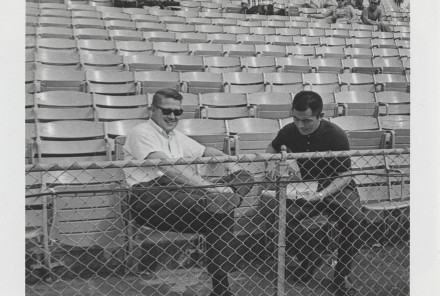
Peter O’Malley and Akihiro “Ike” Ikuhara sit in Holman Stadium, Dodgertown, Vero Beach, Florida, circa 1965. Ikuhara played baseball as a catcher at prestigious Waseda University, Tokyo. He went on to become head baseball coach at Asia University. But his dream was to work for the Dodger organization to learn more about baseball in America. In 1965, Ikuhara was introduced to the Dodgers by Yomiuri sports columnist Sotaro Suzuki and the rest is history.
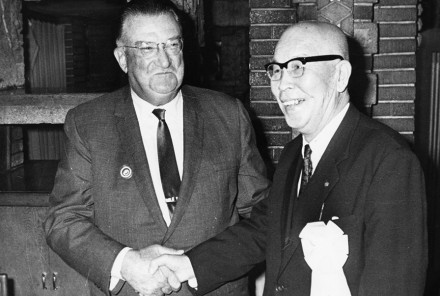
Walter O’Malley shakes hands with Japan Baseball Hall of Fame sports columnist Sotaro Suzuki at a reception for the Dodgers on their 1966 Goodwill Tour to Japan. The Dodgers played 18 games throughout the country in their second goodwill trip to Japan in a decade.
By 1965, Suzuki wrote a letter to Walter O’Malley about a young man who had graduated from Waseda University in Tokyo in 1959, played baseball while there and then was head baseball coach at Asia University. Suzuki informed O’Malley that the young man had followed his writing for years and wanted to learn the ways of a major league team in the United States. Suzuki asked O’Malley if he would be interested in hiring him so he could learn the business side of baseball. When O’Malley said “yes,” that was the start of an important era for the Dodgers, as Akihiro “Ike” Ikuhara would temporarily leave his wife and son in Japan and travel to Dodgertown, Vero Beach, Florida accompanied by Suzuki for Spring Training in 1965.
Ikuhara would then live in Spokane, Washington for two years, while assisting Peter O’Malley who was then president and general manager of the Spokane Indians, the Dodgers’ Triple-A minor league affiliate. That was the beginning of a long-term friendship between Ikuhara and O’Malley. Ikuhara was passionate about baseball and he enjoyed learning all aspects of the Dodgers. At the same time, he was getting used to a whole new culture, learning English and adjusting to life in the U.S., initially without his family. O’Malley and Ikuhara worked together and frequently dined together. Eventually, Ikuhara’s wife Kimiko and son joined him in Washington. Ikuhara was an integral part of what was to come next.
In 1966, Shoriki once again reached out to the Dodger organization to invite them to return to Japan for another fall goodwill tour. Dodger President Walter O’Malley worked closely with Yomiuri representative and friend Suzuki to arrange for the 1966 Dodgers Goodwill Tour, this time playing 18 games throughout the country. Ikuhara was invaluable for the Dodgers in the planning and execution of the 1966 trip, once again sponsored by Yomiuri. United States Vice President Hubert H. Humphrey wrote a letter to Walter O’Malley on May 23, 1966 stating, “I want you to know how pleased I am that the Dodgers will be making a tour to Japan this Fall. I know you realize Walter that it is especially important that all the Dodger players make this trip. As you well know, these visits to Japan are an important part of our American foreign relations…I know the Dodgers will be wonderful American representatives overseas.” Hubert H. Humphrey letter to Walter O’Malley, May 23, 1966, O’Malley collection
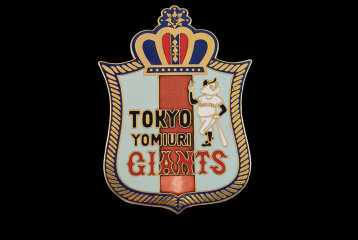
A souvenir pin of the Tokyo Yomiuri Giants distributed by the team during the 1966 Dodgers Goodwill Tour to Japan.
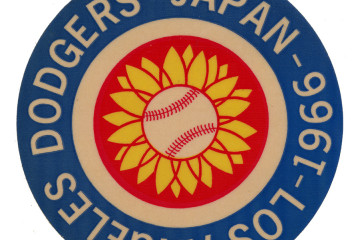
A decal for the 1966 Dodgers Goodwill Tour to Japan featuring the Dodgers and their destination in the outer blue ring. The inside ring shows a baseball at the center of a chrysanthemum, an important flower in Japan to represent longevity and the Imperial family.
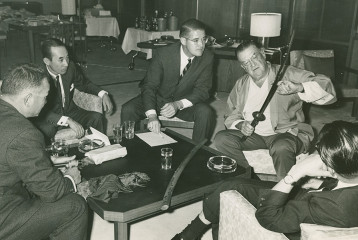
(L-R): Tetsuharu Kawakami, Shigeru Makino, Peter O’Malley, and Dodger President Walter O’Malley. During the 1966 Dodgers Goodwill Tour to Japan, Kawakami, the manager of the Tokyo Yomiuri Giants, presents Peter O’Malley with a gift of a Katana (Japanese longsword) and reminded him to apply powder to it and rub it on the sword every day! Hall of Fame Manager Kawakami won 11 Japan Series, while infielder Makino was serving as a Giants coach and is also a Japan Baseball Hall of Famer.
Once again, Peter made the trip to Japan with his parents, pleased to see the strides baseball had made in the 10 years since the Dodgers had first visited and the positive impact it was making on the country. The Dodgers arrived as National League Champions, having lost in the World Series to the Baltimore Orioles. Peter reunited with Tokyo Yomiuri Giants Manager Kawakami, who in appreciation presented Peter with a Katana (Japanese longsword) that was made in the 1600s. Kawakami also gave Peter powder with the sword, reminding him to apply and rub it on the sword every day!
On this tour, Walter O’Malley met Emperor Hirohito and Empress Nagaka on November 6 and sat with the couple in a private box behind home plate at Korakuen Stadium in Tokyo. It was the first time that the Emperor attended a game involving a major league team. The Dodgers went 9-8-1 on the tour, playing in front of 600,000 fans. The Emperor also bestowed on O’Malley the high honor for a non-Japanese, the Order of the Sacred Treasure, Gold Rays with Neck Ribbon, Third Class for promoting better relations with Japan through baseball. The presentation ceremony for O’Malley was held on November 15, 1966 at the Prime Minister’s Office in Tokyo as he was decorated by Kiyosi Mori, Director General for Prime Minister Eisaku Sato.
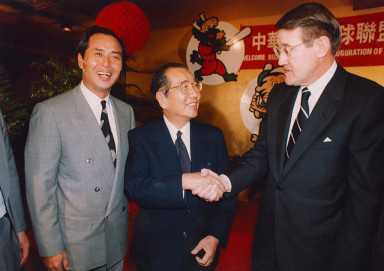
(L-R): Sadaharu Oh, Japan Baseball Hall of Fame player, Tokyo Yomiuri Giants; Toru Shoriki, owner, Tokyo Yomiuri Giants and Yomiuri Shimbun; and Dodger President Peter O’Malley attend the March 17, 1990, reception for the inaugural season of the Chinese Professional Baseball League, Taipei, Taiwan.
In the spring of 1967, the Giants were invited back to Dodgertown for training and they won their third consecutive Japan Series that fall. Shoriki’s son, Toru, was now more involved with the day-to-day operation of the Giants, owned by his father. Toru would travel to the United States frequently to meet with Peter O’Malley, now Dodger Vice President, Stadium Operations, and have a week-long tour of minor league business operations at select Pacific Coast League teams, including Spokane, Washington, where Peter had served as president and general manager in 1965-1966.
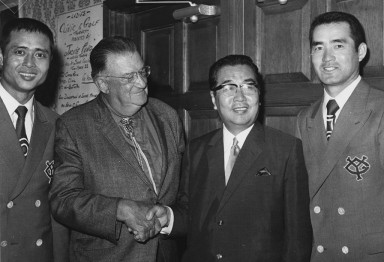
(L-R): Sadaharu Oh; Walter O’Malley; Toru Shoriki, owner, Tokyo Yomiuri Giants; Shigeo Nagashima. In March, 1971, Walter O’Malley welcomes Shoriki and two of the team’s all-time greatest stars, Japan Hall of Famer Sadaharu Oh and Shigeo Nagashima, to the Safari Pines Golf Course at Dodgertown, Vero Beach, Florida.
Dodgertown continued to be a centerpiece of cultural exchanges and goodwill, after Peter was named Dodger President on March 17, 1970 and Walter became Dodger Chairman of the Board. Peter O’Malley invited the Tokyo Yomiuri Giants to return in 1971, 1975 and 1981. With Ikuhara by his side to assist with these spring visits, the friendships became even deeper and stronger.
“Having Akihiro Ikuhara helping me ever since he arrived in the United States in 1965 until he passed away in 1992 was a major factor,” said O’Malley. “Everyone trusted Ike and they always enjoyed seeing him.”
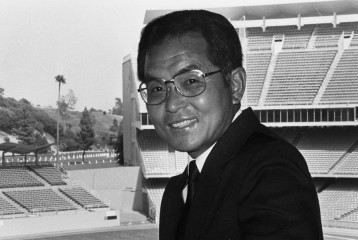
Akihiro “Ike” Ikuhara, Assistant to President Peter O’Malley, at Dodger Stadium. He worked in conjunction with Peter O’Malley for the growth of international baseball, including advocating it as a gold medal sport in the Olympic Games, a dream realized in 1986. Ikuhara was posthumously elected to the Japan Baseball Hall of Fame in 2002.
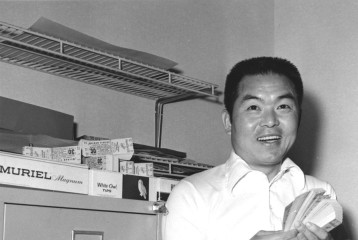
Akihiro “Ike” Ikuhara became Assistant to President Peter O’Malley in 1982. He is shown at the Dodgertown, Vero Beach, Florida ticket office. Ikuhara worked closely with Peter O’Malley to develop international baseball friendships and the emergence of players from Asia to play in the major leagues. Ikuhara was elected to the Japan Baseball Hall of Fame in 2002.
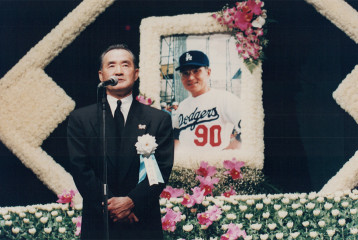
Shigeo Nagashima, who played as a third baseman for the Tokyo Yomiuri Giants from 1958-1974, speaks to the attendees of the memorial service to honor Akihiro “Ike” Ikuhara on January 27, 1993 in Tokyo, Japan. Ikuhara worked for the Dodgers from 1965 until his passing on October 26, 1992. Nagashima played for 11 Japan Series championship teams. Known as “Mr. Baseball”, Nagashima also had two stints managing the Giants in 1975-1980 and 1993-2001. He was inducted into the Japan Baseball Hall of Fame in 1988.
Those training trips were valuable for the growth of professional baseball in Japan. Oh recalled to Peter O’Malley, “You and I had a strong relationship for a very long time. The O’Malley family taught us thoroughly and patiently like we are your family and your passion raised the level of Japanese baseball.” Sadaharu Oh tribute video for Peter O’Malley July 8, 2015 conferment ceremonies, Dodger Stadium
Each visit by the Tokyo Yomiuri Giants to Dodgertown made a significant impact in the on-going relationship. Players came and went through the years, but the friendships and goodwill grew. Toru Shoriki, owner of the Giants, developed a close personal rapport with Peter and his family. The younger Shoriki, who succeeded his father Matsutaro when the elder passed away in 1969, made nearly annual visits to Los Angeles to meet with the O’Malley family. Peter frequently reciprocated in Tokyo, including to establish a “friendly agreement” with the Giants for additional front office and coaching exchanges in 1980.
Though the Dodgers had more interaction with the Giants than other clubs from Japan, through the years the O’Malley family was involved in helping many other teams, as well. At the request of Daimai Orions owner Masaichi Nagata, Walter O’Malley invited 1950 Japan Series MVP Kaoru Betto to Dodgertown in 1960, who remained with the Dodgers throughout the season, observing and learning all aspects of the game. O’Malley formed a friendship with Toei Flyers owner Hiroshi Okawa and sent coaches to instruct Toei, including former Dodger outfielder Pete Reiser. O’Malley sent a gift of a pitching machine to the professional Taiyo Whales. In 1965, O’Malley sent Coach Roy Hartsfield to help with instruction at the request of the professional Chunichi Dragons. He hosted representatives of the Fukuoka Lions at Dodgertown, Vero Beach, Florida.
In 1971, Dodger President Peter O’Malley invited retired bonus player Sadayuki Tokutake of the Yakult Swallows to observe camp during Dodger Spring Training and then remain with the team during the summer. In 1974, O’Malley met with Osamu Mihara, president of the professional Nippon Ham Fighters, at Dodger Stadium. Out of great respect, when Walter O’Malley passed in 1979, the Tokyo Yomiuri Giants held a moment of silence before their game with the Taiyo Whales at Korakuen Stadium.
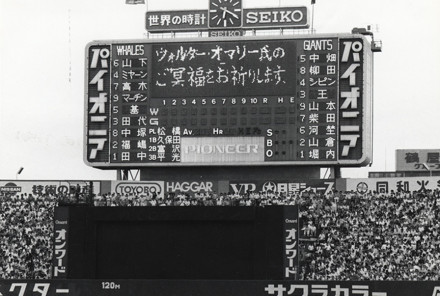
The message in Japanese characters on the message board of Tokyo’s Korakuen Stadium reads, “Pray for the repose of Walter O’Malley’s soul” after O’Malley had passed away on August 9, 1979. O’Malley led the Dodgers on two Goodwill Tours to Japan (1956 and 1966), sent coaches and equipment to support the development of baseball there, as well as hosting the Giants for training at Dodgertown, Vero Beach, Florida.
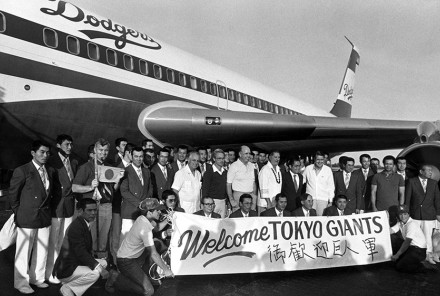
On February 28, 1981, Peter O’Malley (standing above the second O in Tokyo), Dodger Manager Tommy Lasorda (standing above the W in Welcome) and former Dodger Manager Walter Alston (standing above the m in Welcome) are at the Vero Beach Regional Airport to welcome the entire Tokyo Yomiuri Giants team who would stay and train at Dodgertown, Vero Beach, Florida. The Giants were also set to play the Dodgers on March 10.
AP Photo
The Tokyo Yomiuri Giants made five team visits to Dodgertown for training from the 1960s to the 1980s and wound up with four Japan Series championships those seasons.
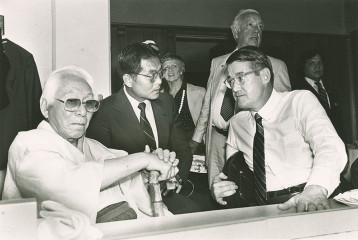
(L-R): Dr. Shigeyoshi Matsumae, founder, Tokai University, Tokyo; Akihiro “Ike” Ikuhara; Dodger President Peter O’Malley; and College Hall of Fame Baseball Coach from USC Rod Dedeaux (standing behind). Dr. Matsumae, a Japan Baseball Hall of Famer, visited Dodger Stadium on June 14, 1983 and met with O’Malley in the Chairman’s Box. Educated as an engineer, Dr. Matsumae received the highest honors from the Japanese government for his service to the country. His dream was to bring countries together through baseball and he privately built Russia’s first baseball stadium in 1989. He and Ikuhara were inducted into the Japan Baseball Hall of Fame.
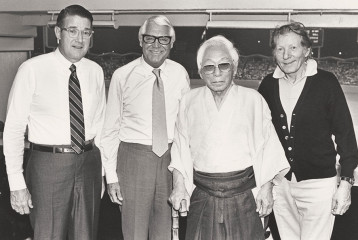
(L-R): Dodger President Peter O’Malley with his friends in the Chairman’s Box at Dodger Stadium for the June 14, 1983 Dodger game including actor Cary Grant; Dr. Shigeyoshi Matsumae, founder, Tokai University, Tokyo, Japan; and entertainer Danny Kaye.
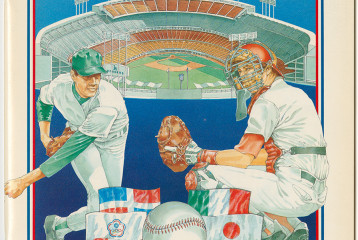
The cover of the official baseball program during the Games of the XXIII Olympiad in Los Angeles. The cover shows Dodger Stadium where the baseball games were played and the eight flags representing the countries that participated in the historic exhibition tournament, which had the third highest total attendance of the Games. Japan defeated the USA, 6-3 in the championship game.
Another important friendship developed as Peter O’Malley met Dr. Shigeyoshi Matsumae, founder of Tokai University in Tokyo, in June, 1973 at Dodger Stadium during the Japan-U.S. College Baseball Championship Series. O’Malley hosted Dr. Matsumae at Dodger Stadium in 1983 and again during the 1984 Olympic Baseball exhibition tournament and discovered that it was Matsumae’s dream to privately build a baseball field in Russia. Matsumae believed that world peace could be established through sports. O’Malley encouraged him to do so, writing him on November 6, 1985: “It seems to me that now is the perfect time to build a baseball field in Russia and I am anxious to discuss this long time dream of yours with you.”
With inspiration from Dr. Matsumae, O’Malley pursued privately building a baseball field in the People’s Republic of China. Working closely with government leaders from China, O’Malley found the ideal location was at Tianjin Institute of Physical and Cultural Education to build the country’s first baseball field. It opened on September 12, 1986 and Dr. Matsumae participated in its Grand Opening. On April 17, 1988, O’Malley and Ikuhara traveled to Moscow State University in Russia for groundbreaking of Matsumae’s Baseball Stadium and returned for its September 1, 1989 Grand Opening and international tournament. In 2007, O’Malley went to Moscow a third time for an international tournament at the stadium. In 2022, Dr. Matsumae was posthumously inducted into the Japan Baseball Hall of Fame.
Due to his personal friendship with Chunichi Dragons Manager Senichi Hoshino, O’Malley invited the professional team from Nagoya to train at Dodgertown in 1988. The Dragons were so smitten with the iconic Dodgers blue script they made their logo the same color and with a similar tail under Dragons. One struggling pitcher on that team received personal attention from O’Malley and his assistant Ikuhara.
Manager Hoshino, a Japan Hall of Famer, asked for pitcher Masahiro Yamamoto to stay back in Vero Beach and play for the minor league Single-A Dodgers while trying to improve his technique. Ikuhara’s encouraging words and mentoring of him to throw a new pitch – the screwball – led to Yamamoto’s complete turnaround and outstanding career. He pitched until he was 50 and won 219 games for Chunichi. He is forever grateful for the kindness by O’Malley and the instruction and friendship from mentor Ikuhara. O’Malley flew to Nagoya to attend a January 18, 2009 reception to celebrate Yamamoto reaching the 200-win mark. In 2022, Yamamoto joined Ikuhara as a fellow member of the Japan Baseball Hall of Fame.
Ikuhara would also help Shigeo Nagashima’s son Kazushige during the 1992 season, as the third baseman played for the Vero Beach Dodgers. Sadly, that fall, Ikuhara passed away on October 26, 1992, and Peter O’Malley lost his close friend and regular traveling partner for all things international.
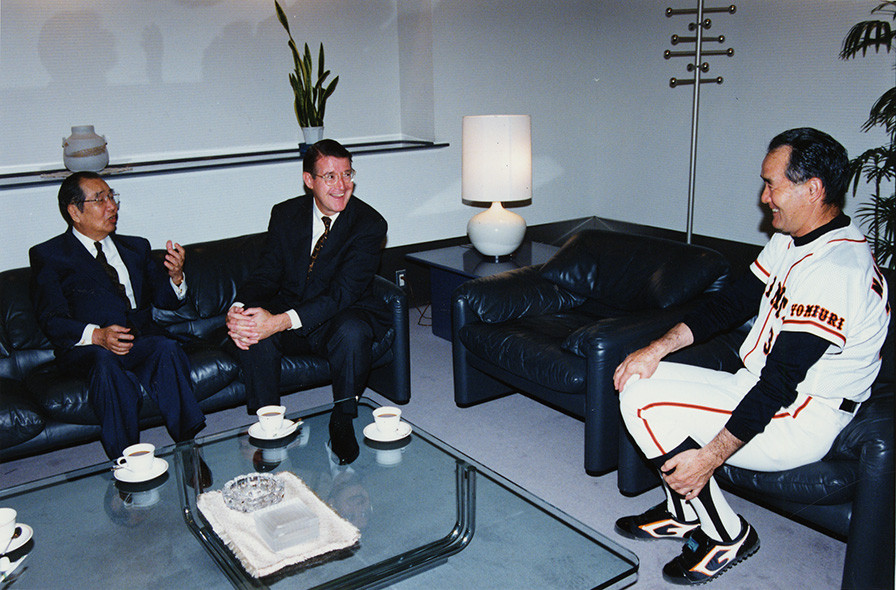
June, 1994 (L-R): Toru Shoriki, owner, Tokyo Yomiuri Giants; Peter O’Malley; and 1988 Japan Baseball Hall of Fame inductee Shigeo Nagashima. Nagashima was a six-time batting champion in the Central League and was elected MVP five times. Nagashima was the regular third baseman on the Tokyo Yomiuri Giants when they won nine consecutive Japan Series from 1965 to 1973. Shoriki was the owner of the Yomiuri Group, the parent company of Yomiuri Shimbun Holdings, the most prominent media company in Japan. The Tokyo Yomiuri Giants were founded by his father, Matsutaro Shoriki, and Toru would later assume his duties.
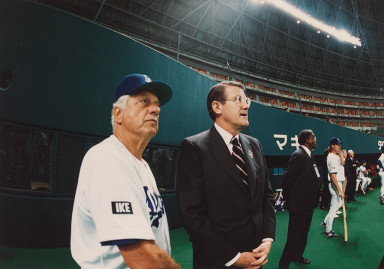
On November 2, 1993, Dodger Manager Tommy Lasorda (left) and Dodger President Peter O’Malley, with National League President Bill White in background at Fukuoka Dome, Fukuoka, Japan. The Dodgers prepare to continue play in the 1993 Friendship Series, as they opened their series with three games in Taiwan, becoming the first MLB team to play there, prior to traveling to Japan for two games. The Dodgers wore a black rectangular shaped patch in honor of longtime executive Akihiro “Ike” Ikuhara.
In fact, the very next year, the Dodgers embarked on a five-game 1993 Friendship Series to Taiwan and Japan. The players and coaching staff all saluted Ikuhara with a black rectangular patch on their uniforms that read “IKE” in white letters. The Dodgers, led by catcher Mike Piazza, pitchers Orel Hershiser and Pedro Martinez, and first baseman Eric Karros, played two exhibition games against the Daiei Hawks who were joined by a handful of Tokyo Yomiuri Giants players at the new Fukuoka Dome. The trip was another visit that was appreciated by fans in Japan and a chance to see major league talent on the Dodgers.
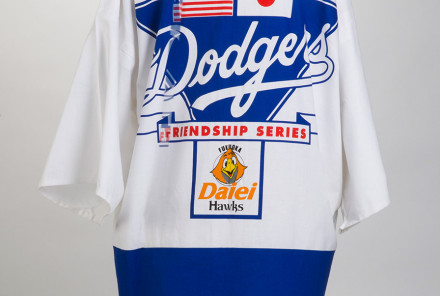
The Dodgers played the Daiei Hawks in Fukuoka, Japan on November 2-3, 1993 as part of the 1993 Dodgers Friendship Series to Japan. To commemorate the series, a happi coat featuring the logo for the series and the flags of the two countries was presented to each member of the Dodgers traveling party. This is the back side of the happi coat presented to Dodger President Peter O’Malley.
Photo for OSP by David Johnston
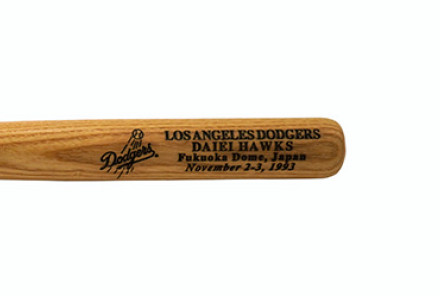
The Dodgers created souvenir mini bats for their 1993 Friendship Series as a special gift to the Daiei Hawks and other friends.
“When Mr. Isao Nakauchi, Daiei owner, extended the invitation to the Dodgers for the first time since 1966, it was a dream come true,” said O’Malley. “The stopover in Taiwan is a result of many friendships with the owners in Taiwan Professional Baseball.”
In 1994, O’Malley invited the baseball team from prestigious Waseda University, Tokyo to Dodgertown, thus becoming the first amateur club to train alongside the major league Dodgers. Ikuhara had played baseball and graduated from Waseda and it was a great way for O’Malley to remember his legacy. Head Baseball Coach Renzo Ishii was a friend of the O’Malleys and he was most appreciative of the opportunity to have Waseda train at Dodgertown. Ishii, who coached Ikuhara’s baseball team at Waseda and was a promoter of international baseball, was posthumously inducted into the Japan Baseball Hall of Fame in 2020.
These bonds were strong and palpable. Whether in the United States or in Japan, any time baseball leaders could get together, the O’Malley family was more than accommodating. Tours were taken, significant gifts were exchanged with deep appreciation, owners were supportive, players were coached and relationships were cemented. Peter estimates he has made approximately 85 trips to Japan.
All of the goodwill tours, the friendships, the travel, meetings, correspondence and phone calls eventually resulted in the signing of Hideo Nomo. It required a signing bonus of $2 million for a player O’Malley had never even seen pitch!
“Our scouts had very minimal reports on him,” O’Malley said. “But friends in Japan, friends in baseball (professional baseball, amateur baseball), they all said, ‘He’s the right guy. He’s tough, he’s strong, he wants to do it, and he’ll do it well.’ So it was more on the personal recommendation of baseball people than a professional scout, because they really hadn’t seen him.” Jason Coskrey, Japan Times, “Former Dodgers owner reflects on Nomo, friendships”, July 2, 2013
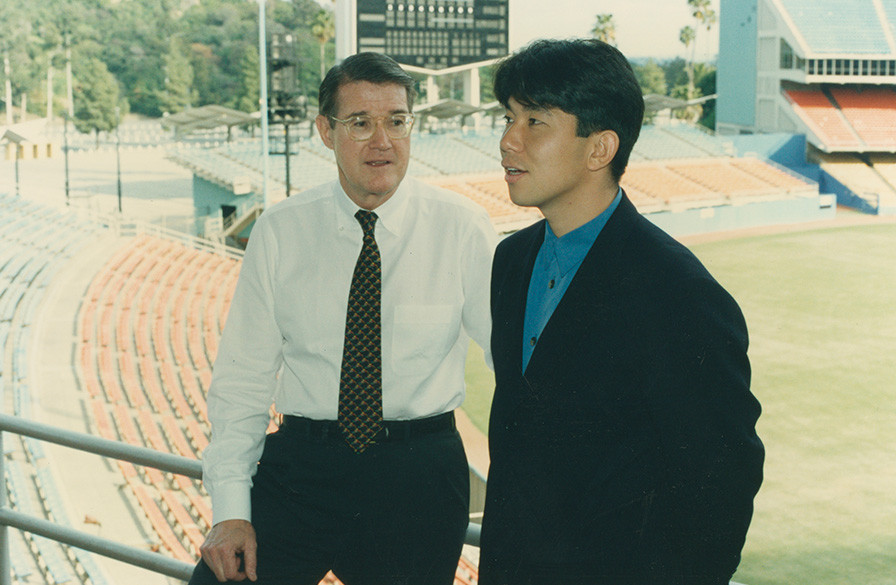
Dodger President Peter O’Malley welcomes his new signee Hideo Nomo to Dodger Stadium on February 13, 1995, the date of Nomo’s contract signing and initial press conference. The two stand just outside of O’Malley’s Dodger Stadium office on the Club Level. Pioneer pitcher Nomo of Japan made his MLB debut on May 2, 1995 against the San Francisco Giants in S.F. He was named starter of the All-Star Game in Texas and won National League Rookie of the Year honors as “Nomomania” swept baseball in two countries.
O’Malley said, “He (Nomo) came to my office on his way to Atlanta and New York. He wanted to see (George) Steinbrenner (owner of the Yankees) and (Ted) Turner (chairman of the Braves). I told him we really wanted him here. This was the best place for him, and we would take good care of him.”Gordon Edes, Boston Globe, April 5, 2007 Nomo and his agent Don Nomura cancelled that trip.
At his introductory press conference after signing a minor league contract with the Dodgers, Nomo said he chose the Dodgers for one main reason. “The (Seattle) Mariners and the (San Francisco) Giants did not have a Peter O’Malley.” Rafu Shimpo, February 14, 1995
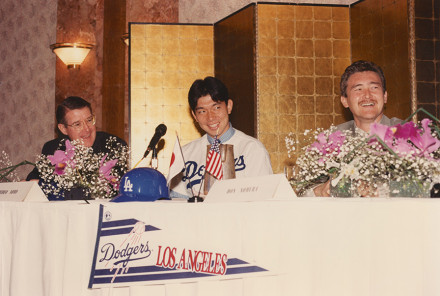
(L-R): Dodger President Peter O’Malley; pitcher Hideo Nomo; Don Nomura, agent for Nomo. It was a happy occasion as O’Malley shares a smile with Nomo and Nomura on the stage for Nomo’s introductory press conference on February 13, 1995 at the New Otani Hotel in Los Angeles. The signing of Nomo, the first Japan-born player to participate in the U.S. major leagues in 30 years, has led to more than 65 players from Japan to play in MLB (as of the 2024 season).
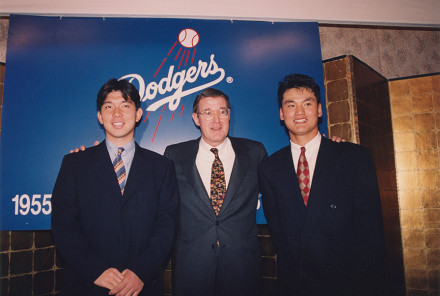
A press conference to introduce Hideo Nomo, who signed as a free agent with the Dodgers, was held on February 13, 1995. (L-R): Nomo, Dodger President Peter O’Malley and Chan Ho Park together at the New Otani Hotel in Little Tokyo, Los Angeles. Nomo and Park were pioneer pitchers representing Japan and South Korea, respectively, and opened the door for more players to come from their countries to MLB.
The news shook baseball to its core. One, because there had only been one other Japan-born player in the United States in 30 years. That was left-handed pitcher Masanori Murakami, who was sent by the Nankai Hawks to the San Francisco Giants organization in 1964 with two other fledgling players. Initially, Murakami was to return to Nankai after a brief stay, but the Hawks did not bring him back to Japan and with a lack of fresh arms on the major league roster, he was promoted to the Giants on September 1, where he became the first Japan-born player to play in the major leagues. A dispute arose over the return of Murakami by the Giants to Nankai and a compromise was struck so that he would remain for one more full season (1965) in San Francisco. Thus, Murakami returned to complete his professional career in Japan, where he played 17 more seasons.
Two, the media from Japan was skeptical about the success of Nomo in the major leagues, wondering how he would fare against the best competition. They wondered how many other players might do the same and were concerned that could lead to the demise of Nippon Professional Baseball.
Three, O’Malley and the Dodgers were taking a significant risk by signing a player from a different country and culture and presenting him with a $2 million bonus. Other clubs were surprised at the size of the bonus and what that would mean for future international signings. But one thing is for sure – baseball fans in two countries were fascinated by Nomo and were curious to see him perform against the best hitters in the game.
For fans in the United States, the Nomo signing came at baseball’s very dark hour of a players’ strike and a cancelled World Series in 1994. The strike continued and lingered into 1995 Spring Training. There was “no joy in Mudville” or anywhere else baseball was played at that time. Replacement players were stocked onto rosters and Spring Training went forward, but it was not the same. Until the strike was suspended in April after 232 days and a second Spring Training was held with MLB players, chaos ruled the game.
Baseball was grappling to find a path forward. It would come on the broad shoulders of a 26-year-old from Osaka, Japan.
Nomura said, “I thought it would be a struggle in the beginning. Peter O’Malley really cared for him (Nomo)…and he wanted Hideo to succeed on the field and off the field. He made sure that (Hideo) was happy with what he was doing, how he was treated, how the environment was for him. So those are very important issues that helped him succeed, and then (perform) well above what he’s done or what people expected of him.” Ed Odeven, japan-forward.com, Second in a Series, July, 2020
Initially, the Dodgers signed Nomo to a minor league contract, as Executive Vice President Fred Claire explained to Nomura and Nomo, “I want you to explain to Hideo that major league contracts in the Dodger organization have been earned, and are not given.” Ed Odeven, japan-forward.com, Fourth in a Series, August, 2020
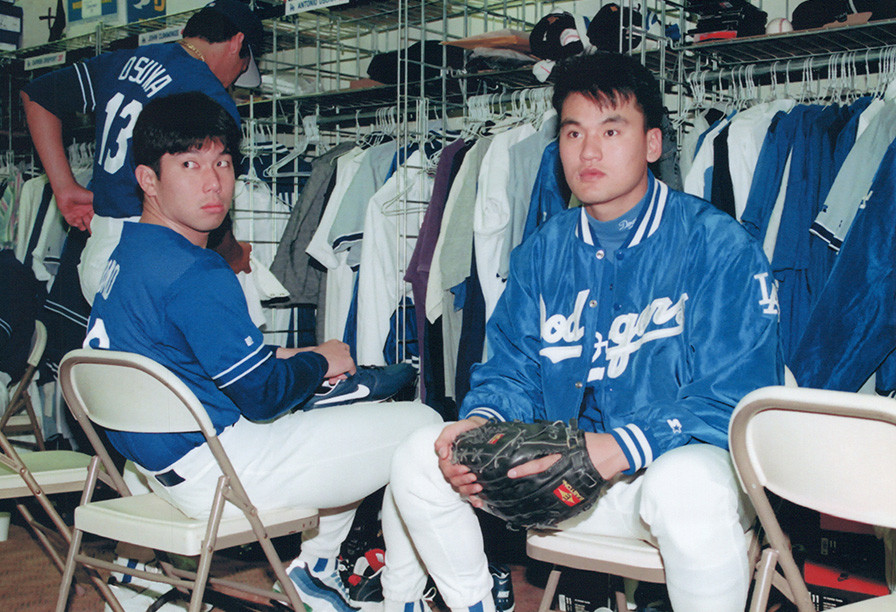
(L-R): Hideo Nomo; Chan Ho Park, circa Spring Training 1996, Dodger clubhouse; Dodgertown, Vero Beach, Florida. Pitcher Antonio Osuna is in the background. Dodger pioneer pitchers Nomo, who won the 1995 National League Rookie of the Year honors, and Park were ready to contribute to the Dodger pitching staff.
The Dodgers first sent Nomo to their Class-A Bakersfield team to pitch on April 27, 1995. He made such an impression there that on May 2, 1995, he made his major league debut in San Francisco against the Giants. From that point, Nomo’s popularity and following only continued to grow.
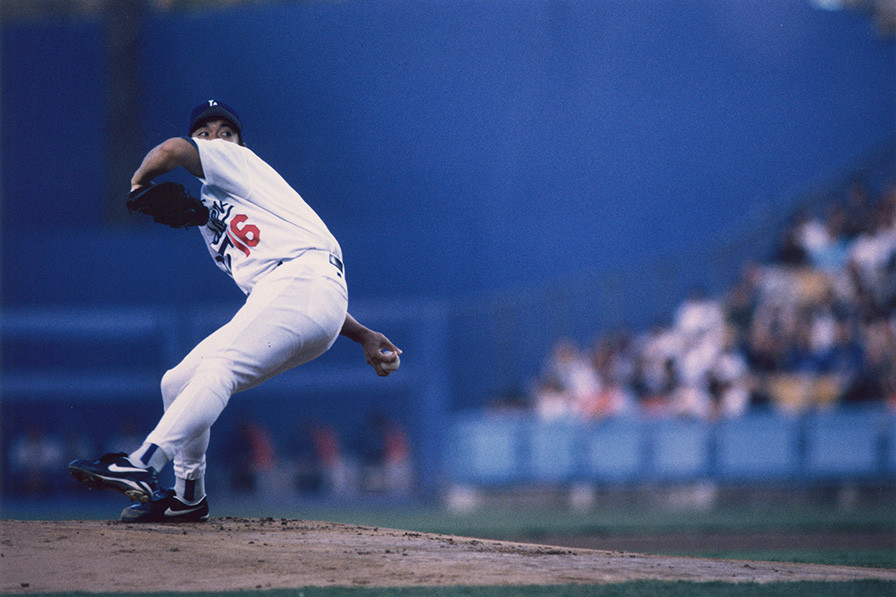
Hideo Nomo, No. 16, on the mound at Dodger Stadium. Known as “Warrior”, Nomo had a twisting and turning delivery style that made it difficult for hitters to pick up the baseball. He was the first Japan-born player to make the major leagues in 30 years and the first to complete his career in America. The National League Rookie of the Year in 1995, Nomo was also selected for that season’s N.L. All-Star team and fans throughout the baseball world were swept up in the excitement of “Nomomania”. Nomo played seven seasons for the Dodgers, winning 81 games of his MLB career total of 123.
He went 6-0 in the month of June and, as a rookie, received the rare selection as starting pitcher for the MLB All-Star Game, which in 1995 was to be played in Texas, where all eyes were upon him. In a spectacular performance, Nomo went two innings and struck out three, while giving up just one single and no runs. At that stage, the phenomenon known as “Nomomania” had taken off like a missile and the pitcher’s every move was chronicled by the media where he was watched like paparazzi chasing a rock star.
“I was surrounded by nervousness as if my own son was the starting pitcher,” said O’Malley who attended Nomo’s performance starting the 1995 All-Star Game. “After Nomo finished pitching and returned to the dugout, I saw everybody congratulating him. I felt relieved and, at the same time, felt warm feelings in my heart that I could not control.” Shuukan Bunshuu magazine, October 26, 1995
Every single game Nomo pitched was televised live to Japan, no matter the start time. Large video screens were installed on street corners in 13 major cities in Japan, so Nomo’s games could be enjoyed. Dodger fans flocked to see him pitch and fans in all National League cities snapped up tickets in anticipation of his next starting assignment. His season kept building with excitement and Nomo’s very modest and humble demeanor endeared him to baseball fans everywhere, who were proud him. They rooted for him and supported him everywhere he pitched. They were proud of what he was able to achieve by following his dream of playing in the major leagues. Nomo was winning over those skeptics who thought he was wrong for picking up, leaving home and performing in the United States. The best major league hitters were baffled by his unorthodox “tornado” delivery, as he twisted and turned with his back to the batter in the wind-up before delivering the ball to home plate. By season’s end, Nomo had won 13 games and was named National League Rookie of the Year.
O’Malley said, “This guy (Nomo) had the heart of a lion. There is no pressure that ever got in the way of Hideo Nomo. He handled pressure better than any professional athlete I’ve ever seen. The word ‘warrior’ came up, both here and in Japan.” He truly was a warrior.” Gordon Edes, Boston Globe, April 5, 2007
Nomo said, “It started with Peter O’Malley, Tom Lasorda and the staff that supported me and made it easy for me to concentrate on baseball.” Ken Gurnick and Austin Laymance, mlb.com, August 10, 2013
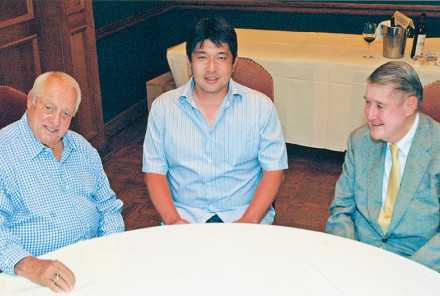
(L-R): In 2018, a reunion of Hall of Fame Dodger Manager Tommy Lasorda; Hideo Nomo, former Dodger pitcher and Japan Baseball Hall of Famer; and Peter O’Malley.
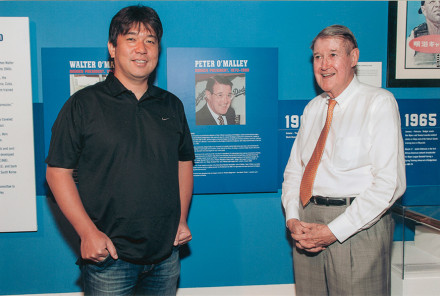
On August 19, 2014, former Dodger pioneer pitcher Hideo Nomo and Peter O’Malley attend an exhibit “Dodgers: Brotherhood of the Game” at the Japanese American National Museum, in Little Tokyo, Los Angeles. Nomo signed with the Dodgers in 1995 to open the door for more than 65 additional Japan-born players to participate in Major League Baseball (as of the 2024 season).
“The fans have fallen in love with him (Nomo),” said O’Malley. “They wanted to see someone new, someone fresh. They have savored every moment.” Bob Nightengale, Los Angeles Times, September 17, 1995
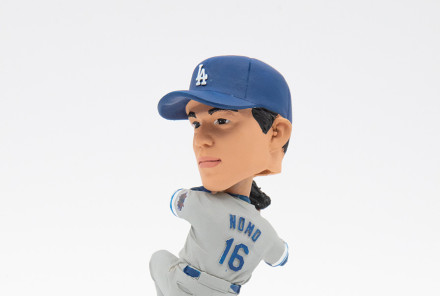
One of several different bobbleheads to commemorate pitcher Hideo Nomo as a Dodger. Nomo signed with the Dodgers in 1995 becoming the first Japan-born player in Major League Baseball in 30 years. He pitched 12 seasons in the major leagues, including 7 with the Dodgers and was named 1995 National League Rookie of the Year. He became internationally famous that season starting the phenomenon of “Nomomania” for his pitching success and revered by fans in Japan who followed his every game.
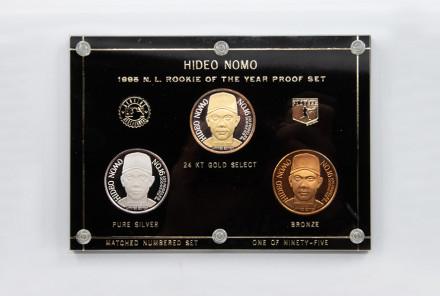
A limited edition coin proof set (No. 1 of 95 made) belonging to Peter O’Malley, which was created to honor 1995 National League Rookie of the Year Hideo Nomo. Nomo won 13 games in 1995 touching off “Nomomania” and helping to save baseball following a prolonged players’ strike. Nomo is one of five major league pitchers to throw a no-hitter in both the American and National Leagues.
Baseball Commissioner Bud Selig who had seen the worst of times just a year before said, “Baseball needs good human-interest stories and the No. 1 story in baseball has been Nomo. Considering what baseball has gone through, with the strike and all our labor problems, the timing couldn’t have been better.” Ibid.
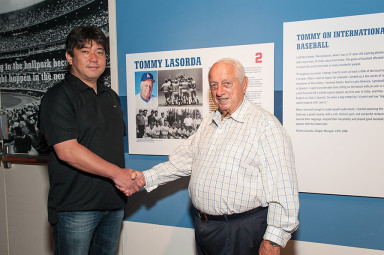
On August 29, 2014, former Dodger pitcher Hideo Nomo and Hall of Fame Dodger Manager Tommy Lasorda are at the Japanese American National Museum in downtown Los Angeles to attend an exhibit titled “Dodgers: Brotherhood of the Game” that covers the relationship of the O’Malley family to Japan baseball, as well as the many pioneering stars of the Dodgers and their significant impact on the game.
Others, including Nomo’s Dodger Manager Lasorda took it a step further stating, “It’s not too much to say that he (Nomo) saved Major League Baseball.” Robert Whiting, Japan Times, First of a four-part series, October 3, 2010
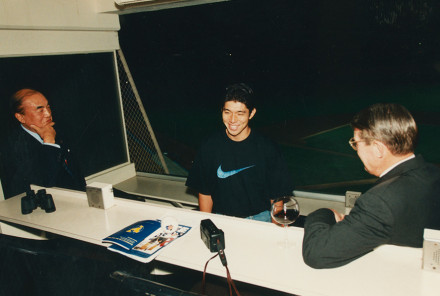
Former Japan Prime Minister Yasuhiro Nakasone (left) meets Dodger star pioneer pitcher Hideo Nomo (center) on September 12, 1996. After pitching a 4-1 victory over the St. Louis Cardinals, Nomo came upstairs at Dodger Stadium to the Club Level to meet Nakasone in the Chairman’s Box. Dodger President Peter O’Malley who met with Nakasone and hosted him is on the right. Nakasone threw the ceremonial first pitch prior to the game and Nomo’s 15th victory of the season. In Nomo’s next start, he no-hit the Colorado Rockies 9-0 in Coors Field, Denver.
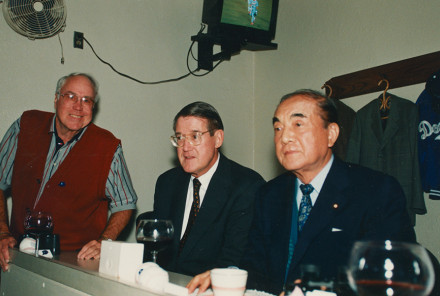
On September 12, 1996, Dodger President Peter O’Malley (center) sits and meets with Baseball Hall of Famer and former Dodger Duke Snider (left) and Yasuhiro Nakasone, former Japan Prime Minister, for the Dodgers and St. Louis Cardinals game in the Chairman’s Box. Nakasone threw the ceremonial first pitch prior to the game and he watched Hideo Nomo start and win that game. After the game, Nomo came up to the Club Level to meet Nakasone.
In 1996, Nomo pitched a 9-0 no-hitter for the Dodgers against the Colorado Rockies in a rain-delayed game at Coors Field, Denver. It’s still hard to fathom, as it remains the only no-hitter at that hitter-friendly ballpark. Legendary Hall of Fame broadcaster Vin Scully said on the Dodger telecast, “Hideo Nomo has done what they said could not be done. Not in the Mile High City, not at Coors Field in Denver. He has not only shut out the Rockies, he has pitched a no-hitter and thank goodness they saw it in Japan!”
O’Malley continued his efforts to help Japan and anywhere else he could, privately building two baseball fields, one for youth and one for adults, in Ireland in 1998, his last full year associated with the Dodger organization. His friendships and interactions in Japan continue to this day. O’Malley has repeatedly said, “I have more friends in Japan than any other country in the world.”
One of those good friends, Senichi Hoshino invited O’Malley to throw the ceremonial first pitch before Game 4 of the 1999 Japan Series between Chunichi and Fukuoka at Nagoya Dome. Hoshino was inducted into the Japan Baseball Hall of Fame in 2017.
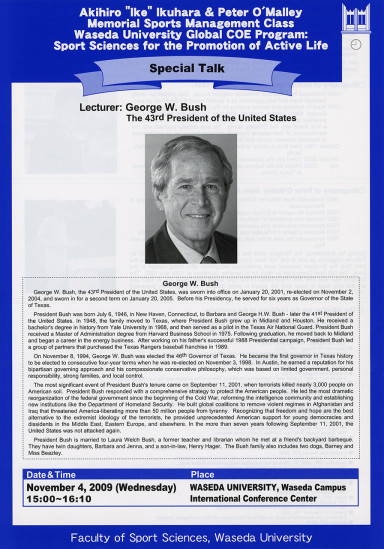
George W. Bush, the 43rd President of the United States, was the guest lecturer for the 12th Class of the Akihiro “Ike” Ikuhara and Peter O’Malley Memorial Sports Management Class at Waseda University, Tokyo. President Bush gave a special talk to the students on November 4, 2009. This is the flyer for the 12th Class.
The former Dodger President established, sponsored, and developed the Akihiro “Ike” Ikuhara and Peter O’Malley Memorial Sports Management Class at Waseda University in honor of his longtime assistant. As a way of helping to develop the next generation of students interested in sports business, O’Malley arranged for 12 lectures over seven years (2003-2009), which included two U.S. Presidents. Although Ikuhara learned on the job the business side of sports, O’Malley felt it was important to offer the students the tools to prepare them for a position in sports, whether it be amateur, college or professional.
In 2011, Dodgertown, Vero Beach, Florida was fading into the possibility of being shuttered for a second time. After the Dodgers were sold by O’Malley in 1998, the Dodgers eventually sold the land to Indian River County in 2001. The Dodgers decided to relocate their spring training home to Glendale, Arizona starting in 2009. That meant that Dodgertown sat idle for nine months in 2008-2009, until Minor League Baseball leased the land and created a year-round training site for multiple sports called “Vero Beach Sports Village”.
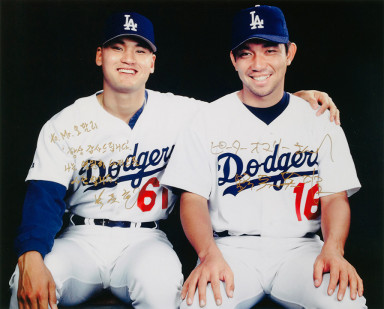
(L-R): Chan Ho Park; Hideo Nomo. A March, 1995 photo of two Dodger pioneer pitchers taken at Dodgertown, Vero Beach, Florida by highly-respected Dodger photographer Jon SooHoo. Park and Nomo later would inscribe and sign the photo for Dodger President Peter O’Malley, who made the two signings. Park pitched for 17 seasons in the major leagues and had 124 wins. Nomo signed with the Dodgers in 1995 and became the first Japan-born player in the major leagues since 1965. He made his debut on May 2, 1995, but his pitching took the baseball world by storm in June and the start of “Nomomania”. He was rewarded as the starting pitcher for the National League All-Star Game in Arlington, Texas in July.
Copyright Jon SooHoo 1995
Two years later after sustaining heavy losses, Minor League Baseball was on the verge of permanently closing the site. But that is when O’Malley stepped up to prevent it. He, his sister Terry O’Malley Seidler, former Dodger pioneer pitchers and friends Hideo Nomo and Chan Ho Park were the founding partners to save Dodgertown. In 2012, O’Malley became responsible for its operation and in 2013 renamed it “Historic Dodgertown – Vero Beach, Florida”. The baseball team from Meiji University of Tokyo, one of Big 6 Tokyo League teams, twice visited the complex to train (2013 and 2016). O’Malley was looking for a long-term solution for responsibility of Historic Dodgertown and he found it in Major League Baseball, which signed a long-term lease with Indian River County and renamed the property, “Jackie Robinson Training Complex” on April 2, 2019.
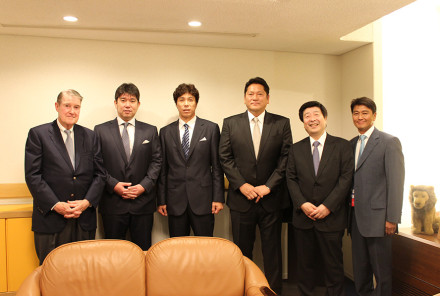
(L-R): Peter O’Malley; Hideo Nomo; Seibu and Fukuoka outfielder Koji Akiyama; Yokohama and Seattle Mariners pitcher Kazuhiro Sasaki; Shinichi Hirose, President, Japan Baseball Hall of Fame and Museum; Acey Kohrogi, Dodger Director, Asian Operations. O’Malley participated in the July 18, 2014 Japan Baseball Hall of Fame induction ceremonies prior to the Nippon Professional Baseball All-Star Game for former Dodger pioneer pitcher Hideo Nomo, Akiyama and Sasaki at Seibu Dome, Tokorozawa, Saitama, Japan. This is a behind-the-scenes moment before the on-field ceremony.
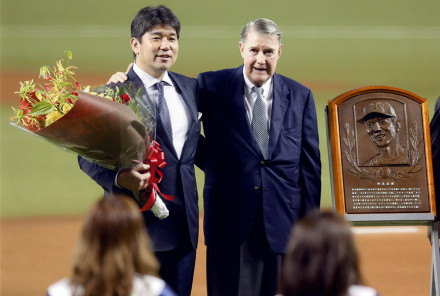
On July 18, 2014, Peter O’Malley (right) is on the field in Tokorozawa, Japan for a presentation of flowers to Hideo Nomo after the former Dodger pitcher had been inducted into the Japan Baseball Hall of Fame. Nomo is the youngest player to be inducted into the Hall of Fame at the age of 45 years, 4 months. He was only the third player in Japan Baseball Hall of Fame history to be elected on the first ballot.
Nomo was inducted into the Japan Baseball Hall of Fame on July 18, 2014 and O’Malley was on the field during the ceremonies prior to Nippon Professional Baseball All-Star Game at Seibu Dome in Tokorozawa, presenting a large bouquet of flowers to his friend. Nomo won 123 games in 12 major league seasons, after playing five seasons and winning 78 games in Nippon Professional Baseball. He was the youngest player ever inducted into the Japan Baseball Hall of Fame.
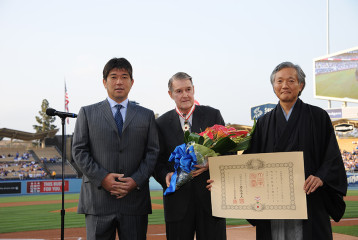
(L-R): Former Dodger pitcher Hideo Nomo; Peter O’Malley; and Hidehisa Horinouchi, Japan Consul General in Los Angeles. O’Malley receives the “Third Class, Order of the Rising Sun, Gold Rays with Neck Ribbon” at Dodger Stadium on July 8, 2015 in pregame ceremonies. It is the highest honor for a non-Japanese citizen.
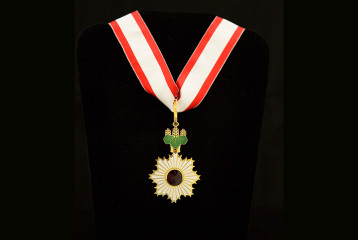
On July 8, 2015, Peter O’Malley was awarded by the government of Japan, the “Third Class, Order of the Rising Sun, Gold Rays with Neck Ribbon”, the highest decoration for a citizen not from Japan. Japan Consul General in Los Angeles Hidehisa Horinouchi presented the decoration during on-field pregame ceremonies at Dodger Stadium, Los Angeles in recognition of O’Malley’s 60 years promoting friendly relations through baseball between Japan and the United States and the development of Japan’s baseball world.
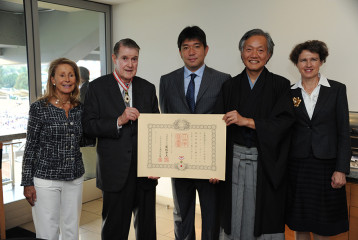
(L-R): Annette O’Malley, wife of Peter O’Malley; Peter O’Malley; former Dodger pitcher Hideo Nomo; Japan Consul General in Los Angeles Hidehisa Horinouchi; Sabine Horinouchi, wife of the Japan Consul General in Los Angeles. Peter O’Malley with the scroll for and is wearing the decoration of the “Third Class, Order of the Rising Sun, Gold Rays with Neck Ribbon” which had been presented on July 8, 2015 by Consul General Horinouchi and conferred by Emperor Akihito in pregame ceremonies at Dodger Stadium.
Photo by Jon SooHoo/©Los Angeles Dodgers 2015
In turn, Nomo presented O’Malley with a bouquet of flowers on July 8, 2015 during conferment ceremonies for O’Malley to receive “The Order of the Rising Sun, Gold Rays with Neck Ribbon,” the highest order for a citizen not from Japan, from the government of Japan. The pregame ceremonies were held on the field at Dodger Stadium before a Dodger game and included video tributes from Oh and Nagashima. Hidehisa H. Horinouchi, then Consul General of Japan in Los Angeles presented the decoration. Horinouchi later became Japan Ambassador to the Netherlands. Crown Prince Akihito, 22, attended the same baseball game at Korakuen Stadium in Tokyo that Peter attended with his parents and sister Terry during the Dodgers Goodwill Tour on November 10, 1956. Coincidentally, Emperor Akihito conferred the honor to O’Malley 59 years later.
Nomo said, “I was very pleased to learn that Mr. O’Malley received this great honor by the Japanese government (conferred by Emperor Akihito). I understand his great contribution to Japanese baseball over many decades. Without his support and hard work to Japanese baseball, I wouldn’t be here.”


